Nîmes is indisputably the most Italian city in France. Consequently, it is rather famous for old structures like the amazing Maison Carrée. In 2023, UNESCO even put this remarkable building on its list of World Heritage Sites. Most rightly so.
However, it’s a shame that far too few visitors are cherishing Nîmes’ wild side and contemporary art. Especially since you don’t even need to visit a museum as you’ll find the best art in Nîmes right on the street, on the houses, and walls of the Gambetta and Richelieu districts.
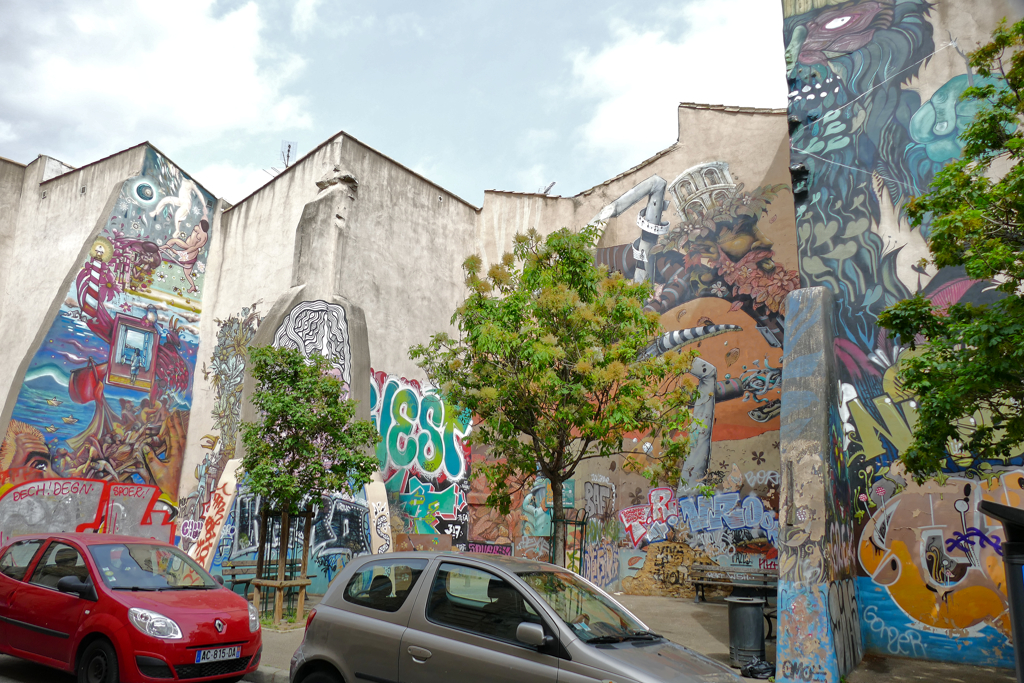
Nevertheless, you should definitely reserve half a day for hunting for street art, no matter what you call the hunting grounds.
- Street Art
- Street Art in Nîmes
- Expo de Ouf
- The Artists
- Charles Foussard
- Tito and Mulk
- Nadège Feron
- Pyrate
- Loraine Motti
- Dr. Ponce
- NEAN
- Adec
- Kopsky
- Cobalt
- Clara Langelez
- MAYE
- Nhobi
- SEMOR
- SUPO CAOS
- Isaac Barreda
- Sismikazot
- Soukoz
- GRUMO
- Wobe Johnson
- RNST
- SWED ONER
- KogaOne
- Aude B.
- María Corrales Orovio
- Le Module De Zeer
- Brokovich
- Dire 132
- SMAK3
- RODES
- Mahn Kloix
- Giuseppe Güntan
- Cole
- FOA
- Elias Taño
- Mister Thoms
- 1sekte
- TANK and POPEK
- Arturo Volátil
- Arkane
- Primal
- ARDPG
- Siou
- Polo 51.67
- On Instagram
- How to Get Around
- Map
- Pinnable Pictures
Street Art
Over the last few years, I have put together many posts about street art in many different countries and often rather unexpected places: from painted walls all over Berlin to an abandoned hotel ruin on the island of Naxos. From socio-artistic ventures in Amsterdam, Copenhagen, and Paris to a glamorous and generously funded art project in Morocco’s capital Rabat. I saw graffiti on the Caribbean island of Martinique and the world’s largest mural in the Korean city of Incheon.
The globe seems to be covered with breathtaking murals by renowned artists.
Due to the abundance, street art has lost much of its subversive swag in many places. In London, the former cradle of punk, groups of tourists push their way through the gentrified and therefore tragically hip districts of Camden and Shoreditch. On the other hand, districts such as the 13th arrondissement in Paris, the Copenhagen Nordvest neighborhood, or the satellite town of San Pablo in the northeast of Seville are visually enhanced through murals in the first step and thereby made more livable in the long term.
And what about Nîmes?
Street Art in Nîmes
Well, while the historic center of Nîmes is a curated and polished gem, you’ll find its powerful urban art rather hidden in the backstreets. Boulevard Gambetta lies north of the proper city center like a social demarcation line. Here the houses are a little more dilapidated, the cafés are a little less elegant, and many residents are a little more tired. The districts of Gambetta and Richelieu are close to the center and yet worlds away. It is a world characterized by workers, craftsmen, and immigrants from France’s former colonies.
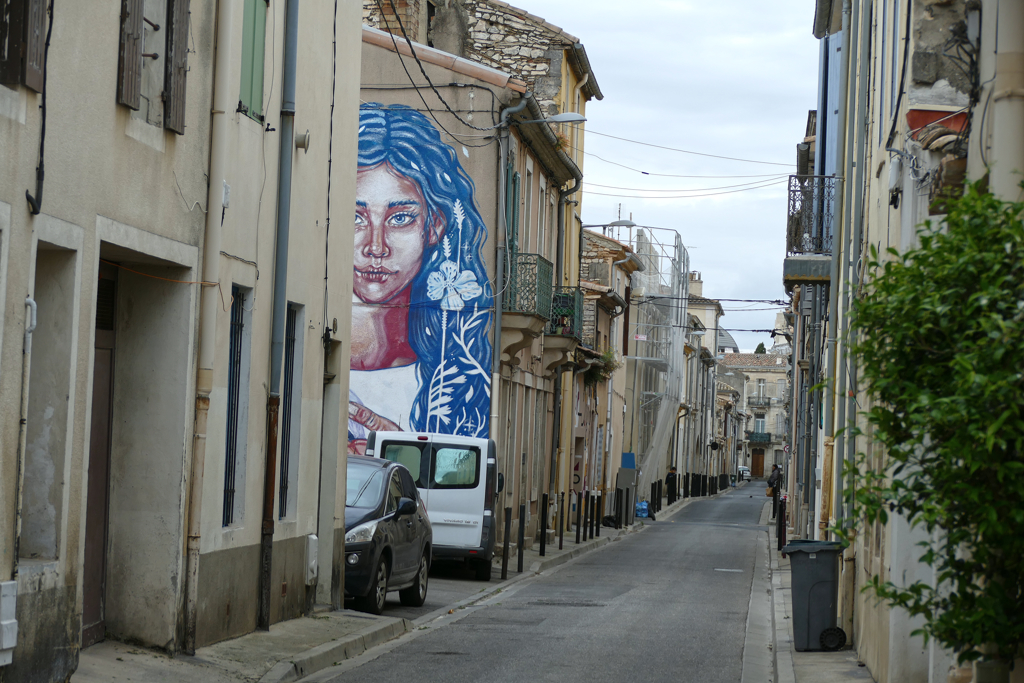
Many of the long-established businesses have to close because no younger successor can be found. It’s not easy to survive in this low-income neighborhood, obviously.
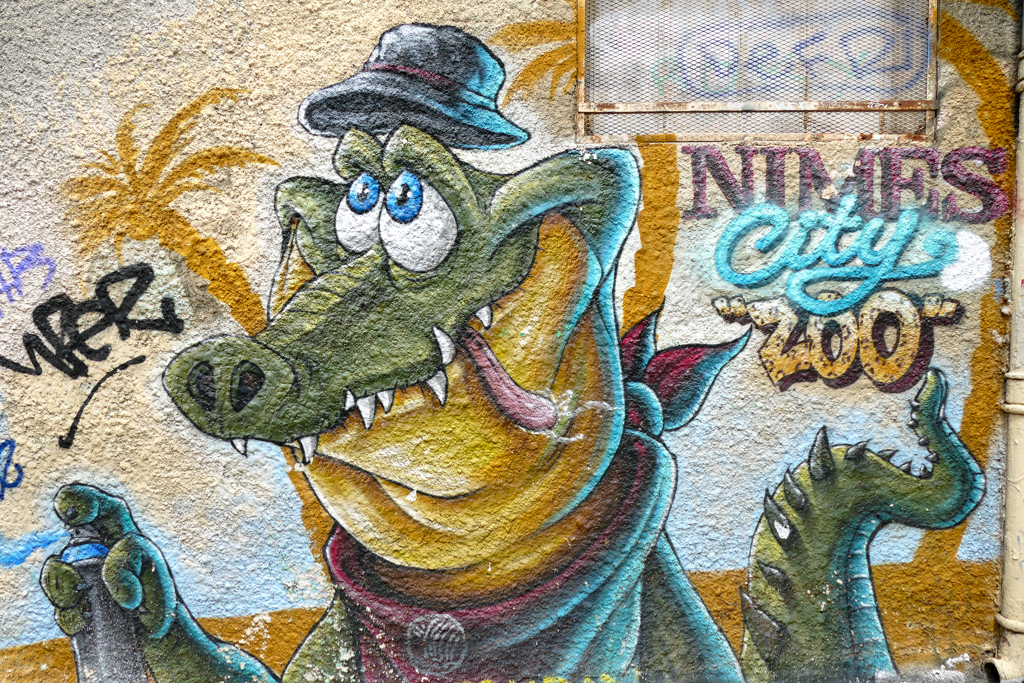
Development programs are intended to give the district the necessary boost. One of the measures is a broader social mix. But that will take time. The other measure can be implemented more quickly: making the district more attractive on the outside. As a result, the first houses have already been renovated. In principle, this is of course a great idea. Nevertheless, such gentrification measures should only be carried out with care and sensitivity. The end goal should be support for the long-established residents and not the neighborhood being handed over to hip bohemians.
Expo de Ouf
As in other cities, the initial impetus for visually improving the run-down neighborhoods through street art came from an art festival. The so-called Expo de Ouf was founded in 2013. Originally launched as a temporary urban art project, the event has since then continuously developed and established itself. Initially, local artists and art lovers organized small, temporary exhibitions and art installations, often lasting just a few days.
Over the course of the first few years, the number of participating artists grew and additional exhibition locations were continually added. The philosophy of Expo de Ouf was to work with local institutions, schools, and cultural associations and to expand the spectrum of events to include workshops, lectures, and performances.
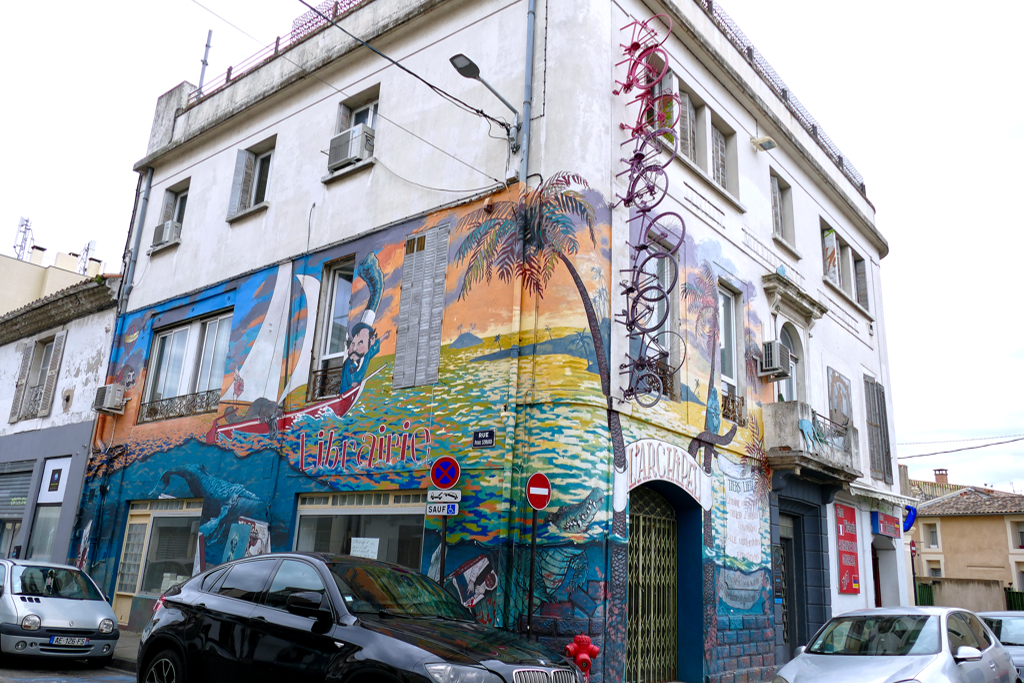
Despite the focus on the development of local districts, artists from other countries also increasingly took part. As a result, a wide variety of motifs and styles can be found in the streets of Gambetta and Richelieu today.
Whatever the case, Expo de Ouf has grown from a small local initiative into a major urban arts festival, attracting both local and international artists and playing an important role in the cultural life of Nîmes.
On my walk through Gambetta and Richelieu, I admired both monumental murals that were created as part of the various editions of the Expo de Ouf festival and discovered cheeky little graffiti.
The Artists
I present the best murals in Nîmes in the order in which I followed the street art route. At the end of the post, there is a city map where you can see the exact location of the works. As always, further below, you will find a list of the Instagram accounts of the featured artists where I have sorted them alphabetically for the sake of clarity.
Charles Foussard
Charles Foussard comes originally from Bordeaux, yet he took his first steps into urban art in the French overseas department of La Réunion. Graffiti inspired him early on.
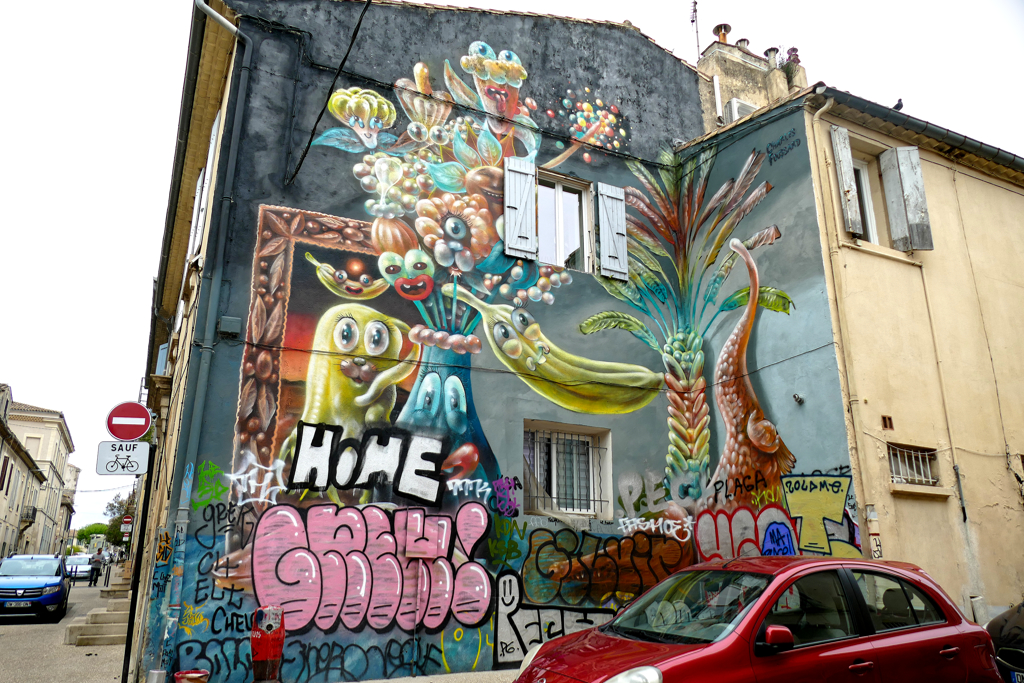
Foussard is known for his lively style. His surreal motifs are influenced by pop surrealism and the Californian lowbrow movement. His picture compositions are often poetic, sometimes almost hallucinogenic.
He thoroughly plans the composition of his work by carefully selecting and photographing the walls to visualize the end result in order to ensure that the interaction of his images harmonizes with the surroundings.
Foussard enjoys creating large murals in public spaces, but also detailed compositions on canvas in his studio. Therefore, his works have been shown in various exhibitions.
I’ve also introduced murals by Charles Foussard in my posts BORDEAUX: Best Street Art on the Left Bank of the Garonne and BORDEAUX: Best Street Art on the Right Bank of the Garonne.
Tito and Mulk
Tito and Mulk are two Parisian artists. They gained recognition for their vibrant and often politically charged artwork, typically characterized by striking black-and-white contrasts, bold colors, intricate designs, and thought-provoking topics. As their paintings often incorporate symbolism and allegory, they encourage viewers to find the deeper meanings behind the visuals. Even though their creations are initially visions of chaos, Tito and Mulk always try to show a way out and convey a touch of hope.

Tito and Mulk’s approach to street art emphasizes collaboration and the importance of community in both the creation and interpretation of their works.
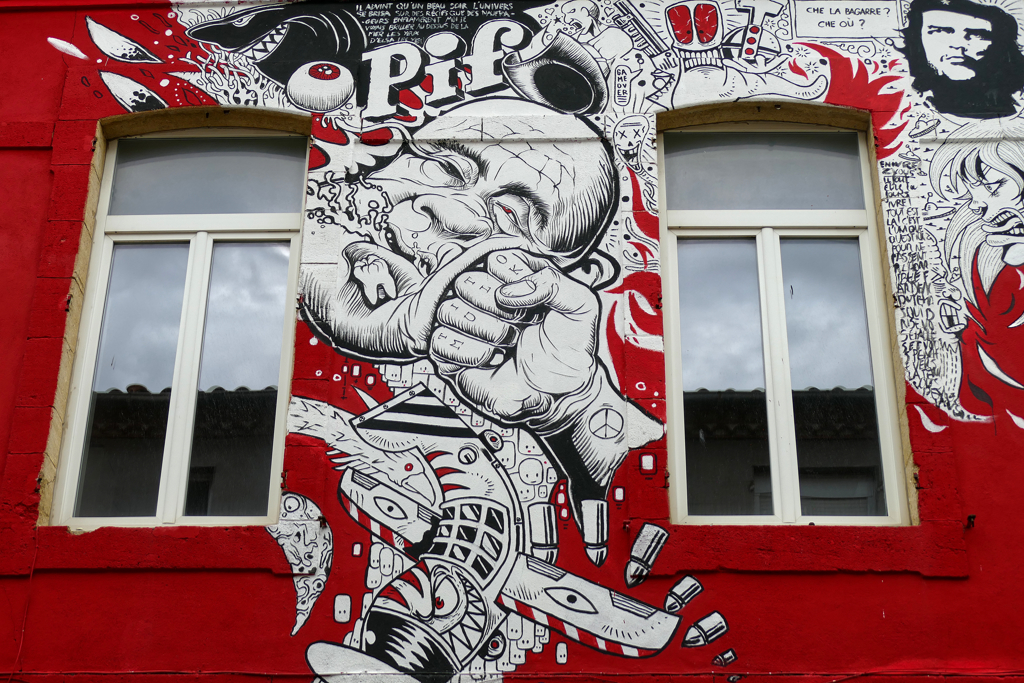
Overall, Tito and Mulk are a dynamic and influential force in the world of street art, using their talents to make powerful statements and enrich public spaces.
Nadège Feron
Nadège Feron was born in the French town of Dreux. She is known for her vibrant and impactful work, which often explores themes of identity and social issues. As you can see from her sophisticated technique and diverse artistic style, she actually studied at various art schools. Today, she draws inspiration from a range of sources including urban culture, traditional visual arts, and contemporary social movements. She has cited influences from other renowned street artists as well as classical painters. Feron works in a variety of media including murals, graffiti, stencils, and mixed media.
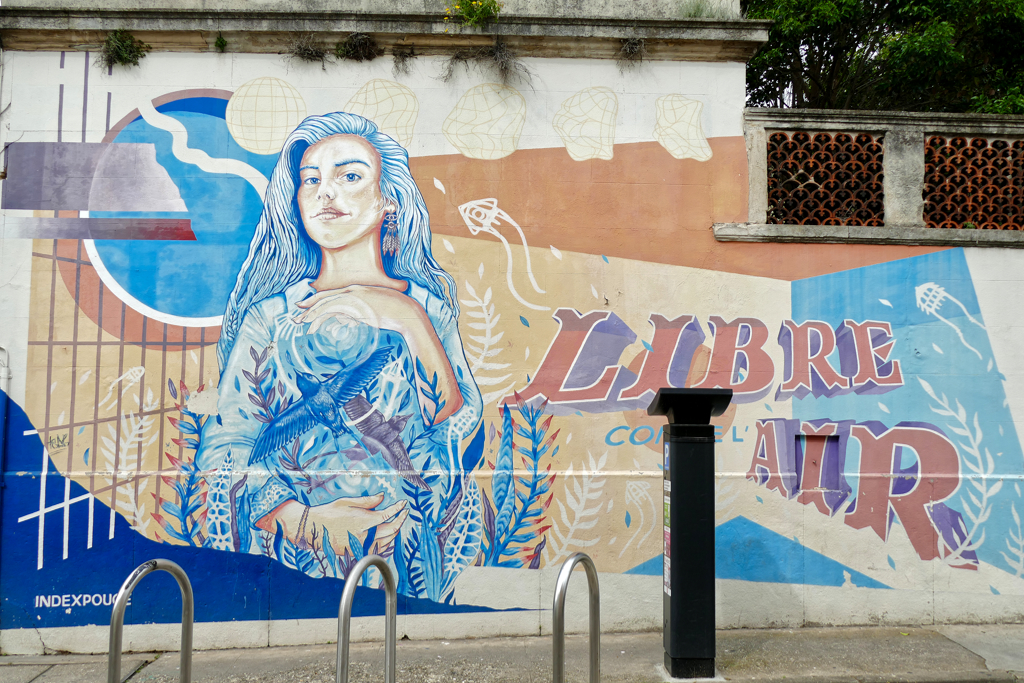
Her art often explores themes such as human rights, gender equality, and the environment. She uses her art to provide social commentary and raise awareness of these critical issues. Feron views her art as a form of activism, using public spaces to challenge norms and inspire change. Her approach is deeply rooted in the belief that art can be a catalyst for social progress.
In addition to her artistic practice, she is involved in educational initiatives, mentoring young artists and leading workshops to nurture the next generation of street artists.
Pyrate
Pyrate was born in the south of France, where he still lives and works today. He was introduced to painting at an early age through his artist father. He developed a passion for drawing during his childhood. At the end of the 1990s, he started making graffiti. Inspired by colors, he evolved his style from year to year and from trip to trip.
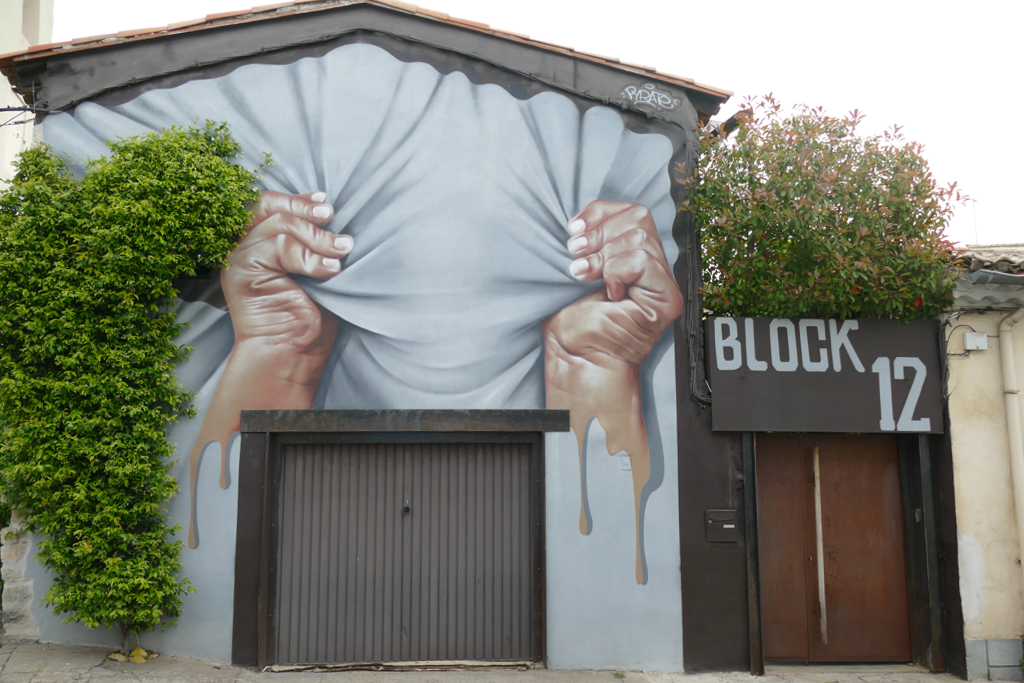
He lived in Brazil for eight months and then commuted between New York, Tokyo, and various cities in Europe. Thanks to his family legacy, he remained loyal primarily to classical portraits, which he implemented in a hyperrealistic style.
Loraine Motti
After she began painting in 2009 in the desolate surroundings of the Paris region, Loraine Motti developed artistically during her time in Chile, where she has lived since 2014. There her style took clear shape.
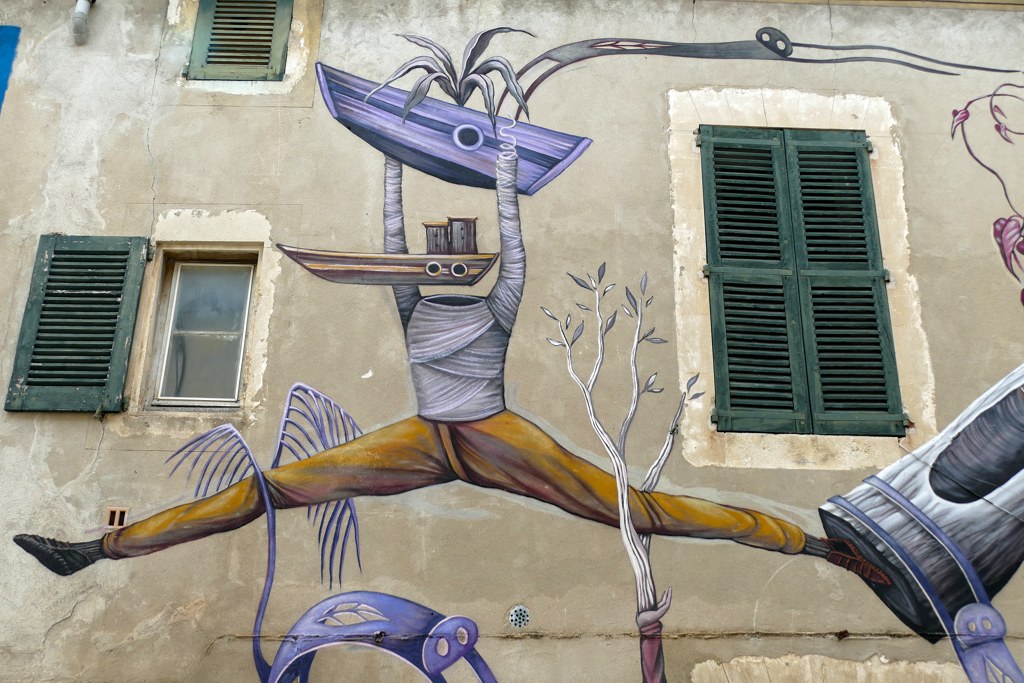
Today, Loraine Motti lives in Lyon, and her style has evolved in a surrealistic direction. A recurring theme is the landscape, which she interprets in a poetic and idealistic way. Thanks to a unique selection and combination of colors, her works have a dreamlike appearance.
Loraine Motti works with both acrylic paints and aerosol techniques. This allows her to create both monumental works and small-scale paintings. She therefore works on canvas, paper, and façades.
Dr. Ponce
Hugo Ponce aka Dr. Ponce is a renowned street artist from Mexico whose work features a unique blend of traditional painting techniques and urban aesthetics. Having formal training in fine art, Ponce’s work is influenced by both classical art and contemporary street art movements. He works in a variety of media including spray paint and acrylic. His works are often characterized by detailed lines, bright colors, and intricate compositions.
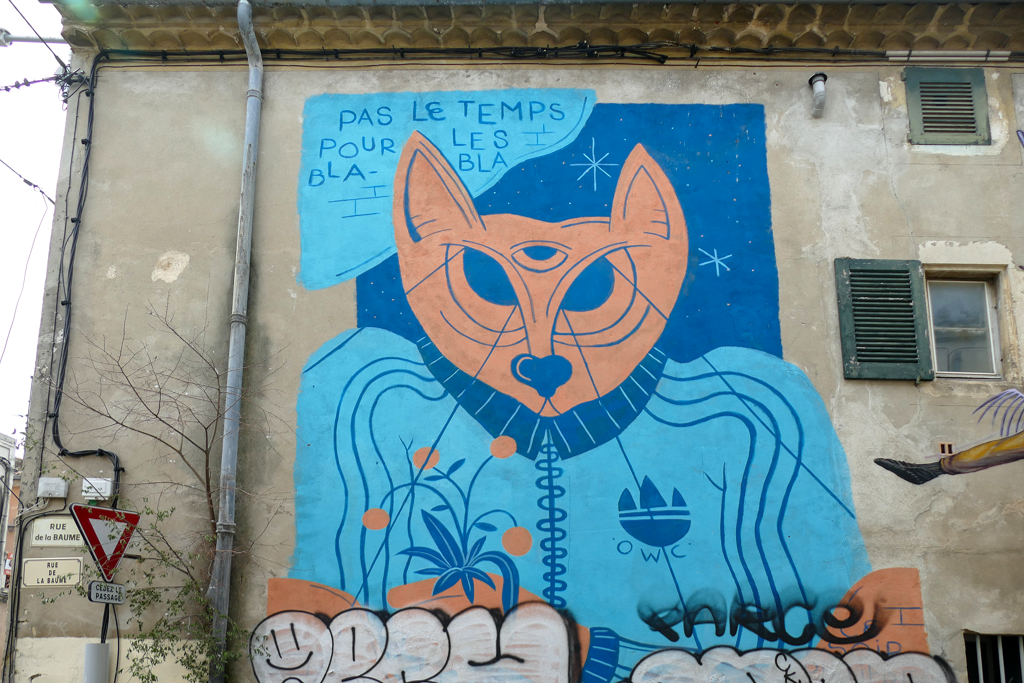
His subjects cover a wide range of topics, including cultural heritage and social issues. Also, he often incorporates elements of Mexican culture and history in his pieces. Additionally, Ponce has collaborated with other artists and organizations on projects aimed at bringing art into public spaces and engaging communities. The focus of these collaborations is often on cultural exchange and artistic innovation. Ponce views his art as a way to express and preserve cultural identity. His pieces often reflect his Mexican heritage, combining traditional motifs with contemporary styles.
He has participated in numerous solo and group exhibitions, proving his ability to move seamlessly between street art and white cubes. Further, his work has been featured in various publications, earning him a reputation as one of the leading figures in contemporary street art.
In addition to his artistic practice, Ponce is committed to teaching and mentoring young artists. He conducts workshops and lectures to share his knowledge and inspire the next generation of street artists.
NEAN
Fabien Hupin aka NEAN is a prominent street artist from Brussels. The self-taught artist, born in 1991, made his first artistic attempts on paper. Later he resorted to spray paint. Today, NEAN is known for his highly detailed, figurative works that combine traditional painting influences with modern techniques. He often combines this with a photorealistic style. His works are often thought-provoking and encourage the viewer to find their own interpretations and connections.
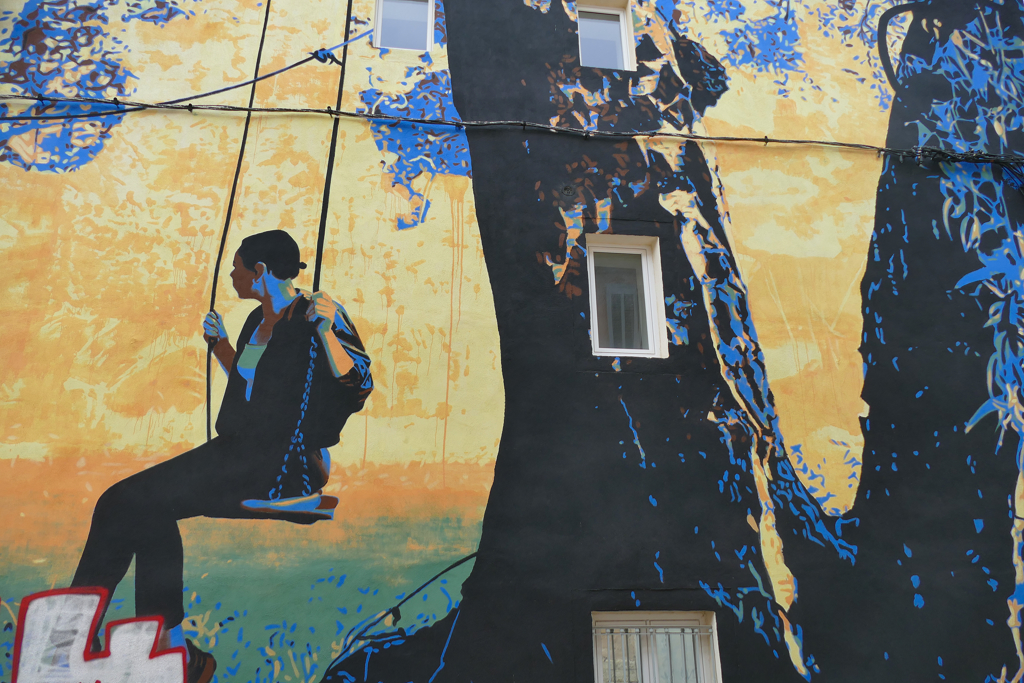
His art is characterized by meticulous attention to light and color. As a result, he creates poetic, almost melancholic works. Nean is inspired by European Art Nouveau artists such as Gustave Klimt, Egon Schiele, and Alphonse Mucha. He combines tradition with contemporary street art techniques. In addition to his murals, NEAN participates in art projects and festivals.
I’m introducing more murals by NEAN in my post Best Street Art in Brussels.
Adec
Italian street artist Adec is known for his vibrant and dynamic works. He grew up in an urban environment, surrounded by the burgeoning street art and graffiti scene. This early inspiration clearly influenced his artistic development. His art is characterized by bright colors, sharp lines, and a combination of abstract and figurative elements.
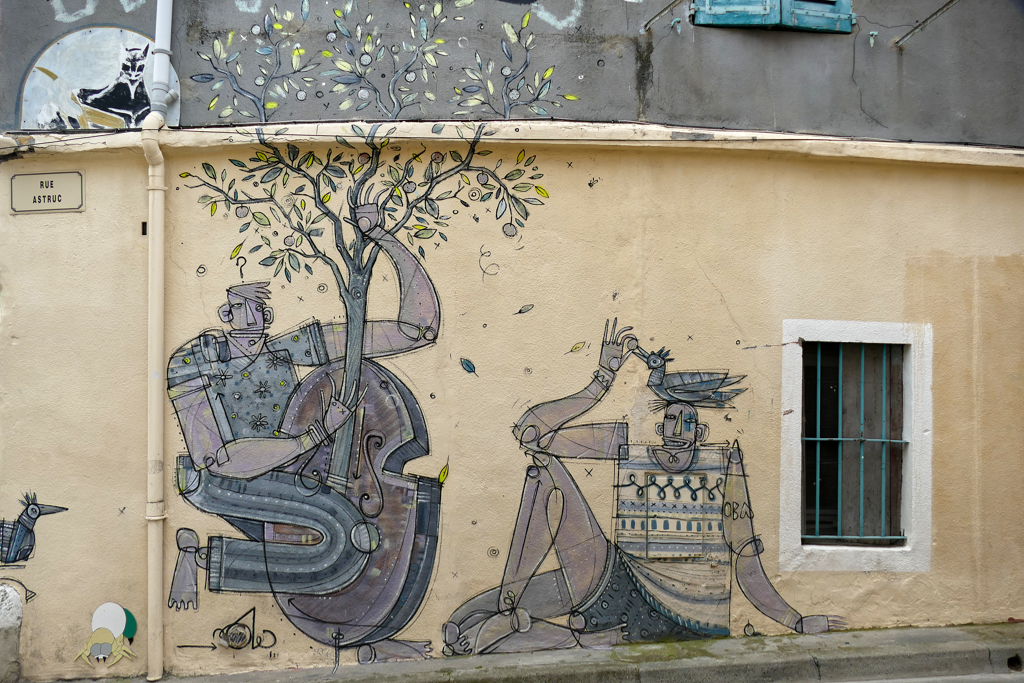
In his work, he often deals with topics such as urban life, cultural identity, and social issues. He often incorporates elements of pop culture, surrealism, and abstract expressionism.
Adec has participated in numerous street art festivals and contributed to the cityscape with his unique style. His ability to combine traditional graffiti techniques with contemporary artistic approaches has made him a prominent figure in the world of street art. He has gained widespread recognition in the street art community and beyond. His work has been featured in art exhibitions, publications, and online contemporary art platforms.

Adec believes in the transformative power of street art to enhance urban environments. His murals enliven often neglected areas and bring color and life to otherwise dreary spaces.
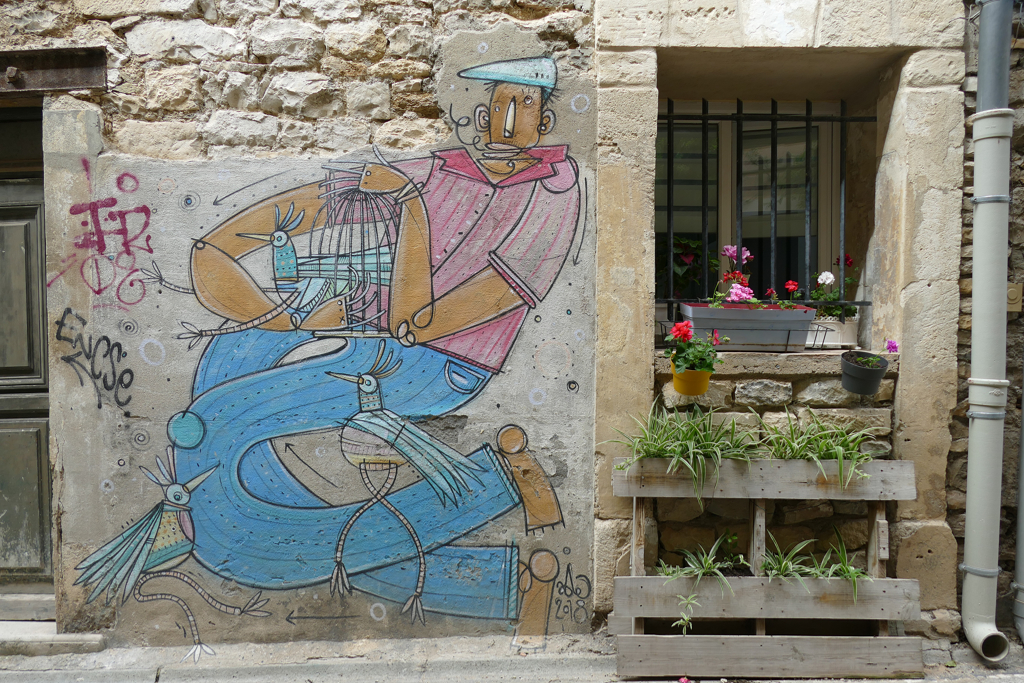
In addition to his personal projects, Adec is involved in community-based art initiatives. He works with local organizations to create public art that reflects and serves the needs of the community.
Kopsky
Kopsky is an emerging street artist known for his distinctive style and impactful works, which often combine humor, social commentary, and striking visual elements.
Growing up in Paris, he was exposed to graffiti and mural painting at a young age, which greatly influenced his passion and development as an artist.
To create his art, which features bold lines, bright colors, and a mix of abstract and figurative elements, Kopsky primarily uses spray paint and stencils.
His work often explores themes such as identity, culture, and social issues. However, Kopsky often uses satire and irony. In fact, Kopsky views his art as a tool for social commentary. His goal is to create works that are not only visually stunning, but also meaningful and address important topics from a creative perspective.
He has participated in numerous street art festivals and contributed to the cityscape with his unique style. These festivals provide artists with a platform to showcase their work and engage with a global audience.
He has also collaborated with other artists on various projects.
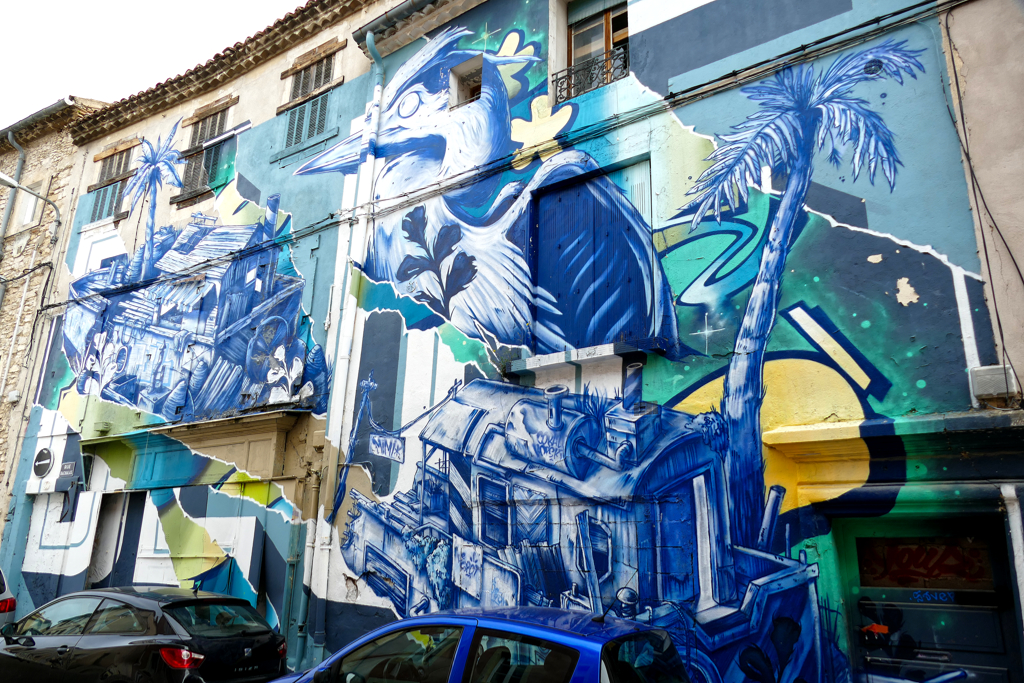
Kopsky’s work shows the dynamic development of street art. His ability to combine humor with social commentary has made him a distinctive voice in the world of street art and contributed to the cultural vibrancy of the communities he works with.
Cobalt
Cobalt is known for his distinctive style that combines vibrant colors and geometric shapes with a touch of surrealism. Because he grew up in an urban environment, he came into contact with the lively street art scene at an early age. His initial fascination with graffiti and murals in Paris played a crucial role in his artistic career.
Primarily using spray paint and stencils, Cobalt often incorporates elements of mixed media to add depth and texture to his works. The influences on Cobalt’s style range from classic graffiti and modern street artists to abstract and surrealist painters. He draws inspiration from artists such as Piet Mondrian for geometric influences and Salvador Dalí for surrealism.
Through his art, he touches on a variety of topics, including urban life and the human condition. Cobalt’s works are known for their abstract nature, often mixing reality with surreal elements. His murals often feature bold geometric patterns and vibrant color schemes, creating an impressive effect.
Cobalt has collaborated with other street artists such as Kopsky, whose profile you find above.
Over the years, Cobalt has gained widespread recognition in the street art community. His work has been featured in exhibitions, art publications, and online contemporary art platforms.
He believes in the transformative power of art, especially in urban environments. Therefore, his goal is to transform everyday spaces into visually stimulating experiences that can uplift and inspire the community. In addition to his personal projects, Cobalt is committed to local art initiatives. He works with various organizations to create public art that reflects and enriches regional culture.
Clara Langelez
Clara Langelez is known for her unique and expressive style, which often explores themes such as femininity, nature, and social issues. She has an academic background in fine arts, having been educated at art schools where she honed her skills in painting, drawing, and other artistic techniques. This formal training has influenced her sophisticated style. She works in a variety of media, often combining traditional painting techniques with street art elements.
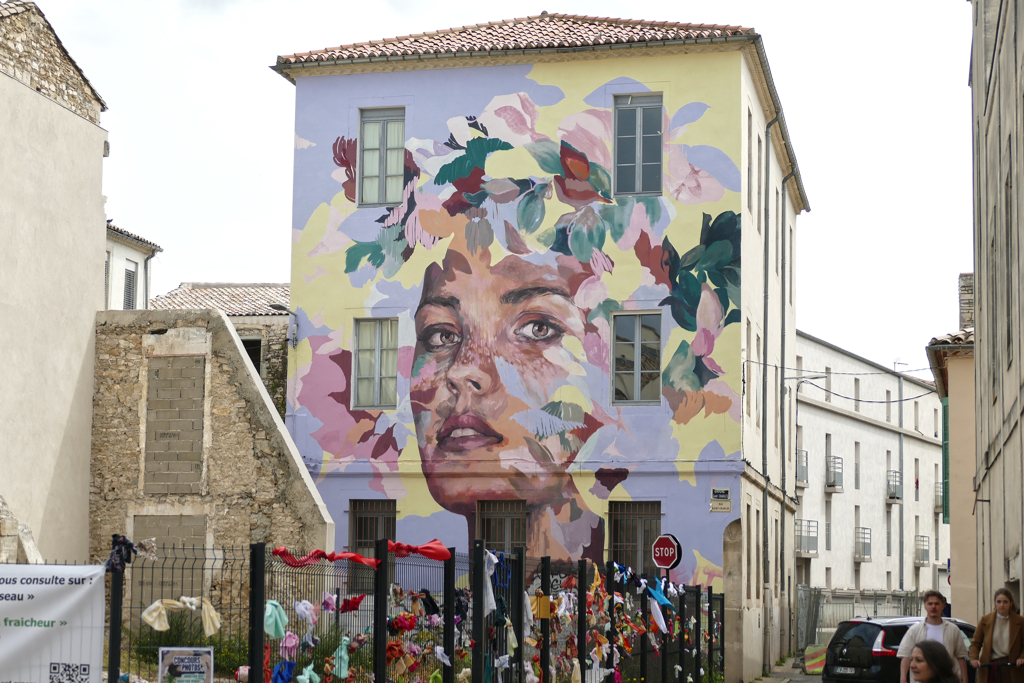
She uses her art to convey powerful messages about gender equality, environmental issues, and personal identity. She draws inspiration from a range of sources. Artists such as Frida Kahlo and Banksy have influenced her thematic choices and artistic techniques.
Clara Langelez is known for her large-scale murals, found mostly in France. These murals often feature intricate designs, vibrant colors, and emotional depth. In addition to her street art, Langelez has also exhibited her work in galleries. These exhibitions have helped bridge the gap between street art and fine art.
Langelez’s art is celebrated for its ability to captivate and move audiences. Her murals often stimulate thought and discussion. She has gained recognition in the street art community and the art world at large. Her work has been featured in various art publications, exhibitions, and online contemporary art platforms.
Langelez views her art as a tool for advocacy and social change. Her goal is to raise awareness of important issues such as gender equality and environmental protection.
Clara Langelez’s work exemplifies the transformative power of street art. Her ability to combine emotional depth with social commentary has made her a distinctive voice in the world of urban art.
MAYE
Victorien Liria aka MAYE was born in Sète but grew up in Montpellier. At the age of 13, he discovered graffiti and hip-hop culture. Today he is best known for his whimsical and surreal murals, which often depict dreamlike characters, animals, and scenes that invite the viewer into a world of fantasy and curiosity. A recurring theme in his work is the interplay between natural elements and fantastical motifs, combining the two to create a unique visual narrative.
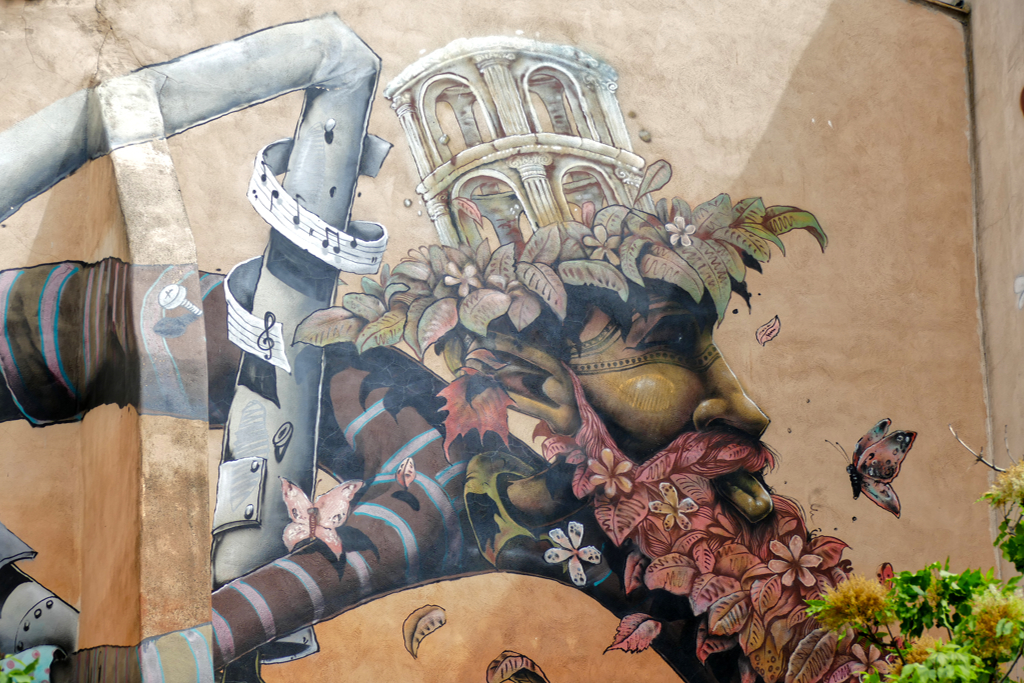
Therefore, MAYE’s murals have a significant impact on the beautification and revitalization of urban spaces, transforming otherwise everyday walls into fascinating works of art.
MAYE’s works can be found in various cities around the world, each uniquely tailored to its location and often reflecting the cultural and historical context of the region.
Nhobi
Fabio Cerqueira aka Nhobi is a Brazilian street artist based in Marseille. He is known for his vibrant and playful murals. The artist, originally from Rio de Janeiro, moved to France in 2012 and quickly made a name for himself in the local street art scene. His works feature bright colors, tropical themes, and a whimsical’n’witty style.

It all started with his passion for drawing. Graffiti enabled him to present his drawings to a wider audience. So he started tagging when he was 13. Ultimately, he also dedicated himself to art professionally.

Today, Nhobi mostly depicts simple and naive characters, infused with elements of Brazilian culture. His works can be seen all over Marseille, particularly in the Le Panier district and the Cours Julien. Both neighborhoods are famous for their rich street art scene.
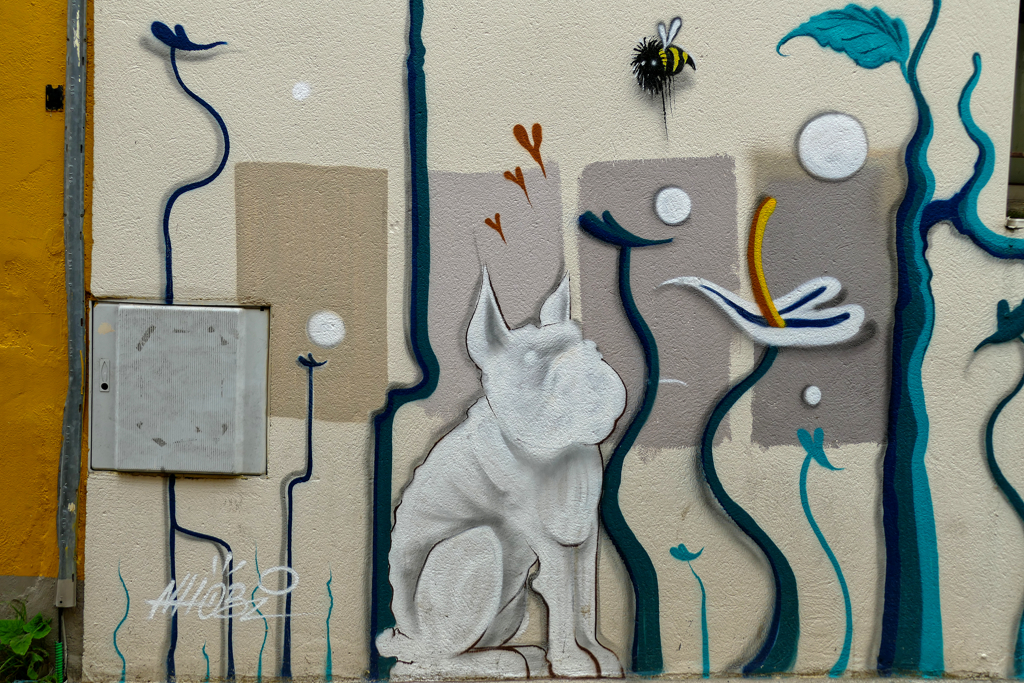
In addition to his individual works, Nhobi is also involved in community projects that aim to bring attention to environmental issues.
I’m introducing more of Nhobi’s works in my post Best Street Art in Marseille.
SEMOR
Kai Niederhausen, better known as Semor or Semor the Crazy, is a German street artist known for his unique blend of traditional graffiti and modern artistic elements. This fusion creates a unique aesthetic that distinguishes his work. This has made him a prominent figure in the world of street art. His work has been featured in various art publications, documentaries, and online contemporary art platforms.

Semor mainly uses spray paint, markers, and acrylic paints. His art touches on a variety of themes, including urban life and personal identity. His works are characterized by a mixture of graffiti lettering and figurative elements.
Semor’s murals can be found in various cities across Europe. They often feature complex compositions, bright colors, and a mix of abstract and figurative elements. In addition to street art, Semor has exhibited his art in galleries. These exhibitions often feature a mix of his graffiti-inspired works and more traditional paintings.
Semor’s goal is to create works that are not only visually impressive but also deep and stimulating.
SUPO CAOS
SUPO CAOS is an extremely prolific artist. Originally from Nîmes, he is a local hero of his hometown’s street art community. He achieved particular merit as artistic director of the Street Art Festival Expo de Ouf.
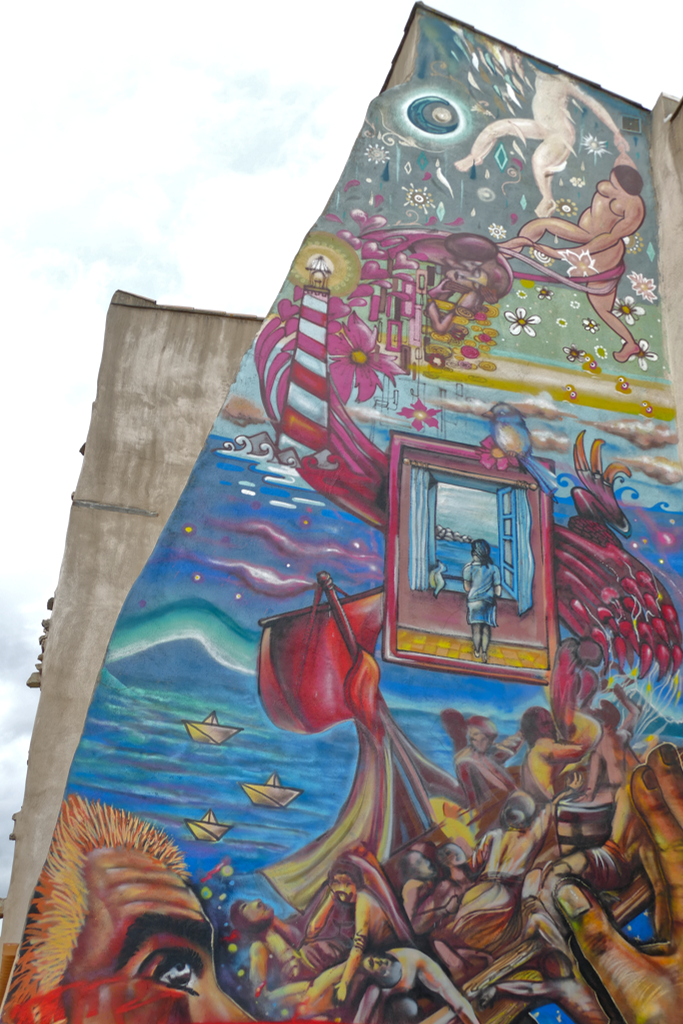
With his paintings, SUPO CAOS, who also works as a graphic designer, amuses with small, whimsical stories.
His works are an integral part of the city walls of Nîmes.
Isaac Barreda
Isaac Barreda was born in the Peruvian capital Lima. At the age of 19, he joined the first Peruvian graffiti group DMJC.

Since he was also very interested in classical painting techniques, he attended workshops and learned how to use gold leaf. He also worked at the pre-Columbian archaeological site of Chan Chan on the northwest coast of Peru.
The color scheme is based on Fauvism, while the use of light comes from Impressionism. All of this combined with traditional graffiti makes Isaac a virtuoso of street art.
Sismikazot
Sismik and Azot are renowned French street artists who work together under the name Sismikazot. They combine their unique artistic skills and perspectives to create works that are greater than the sum of their parts. Their collaboration allows for a fusion of styles and ideas, resulting in striking and cohesive murals. Each artist has different strengths and their collaboration often involves integrating different techniques and methods to enhance the overall impact of their works.
All of this has made her a fixture in the French urban art scene.
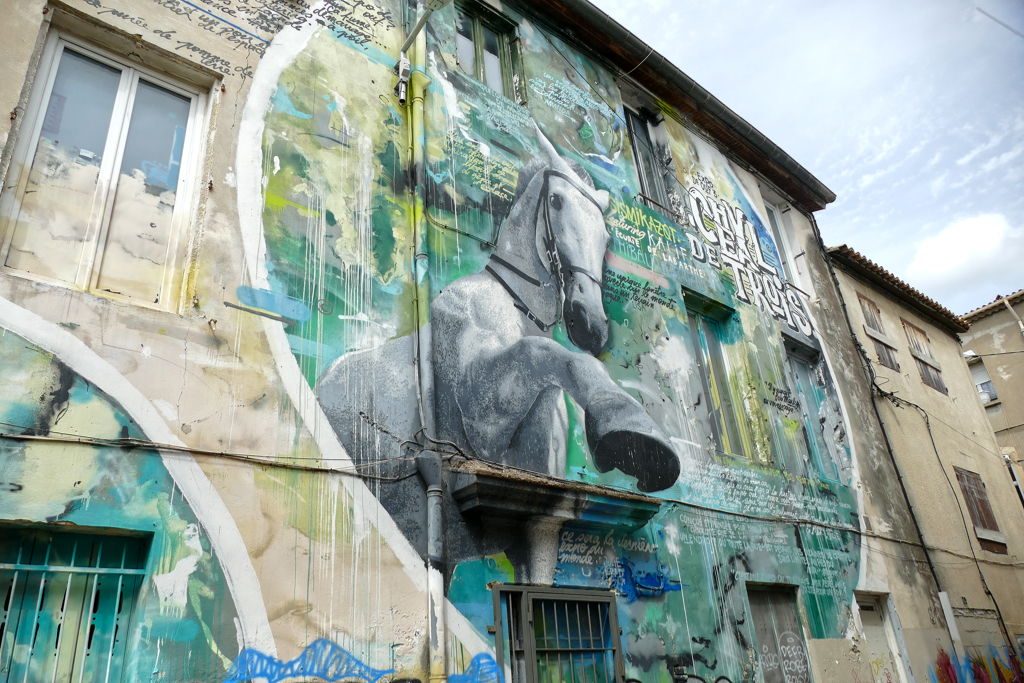
Her murals often address social and political issues and provide commentary on contemporary events and societal challenges. They want to use their art to stimulate thought and change.
Her work often incorporates a mix of realism and surrealism, creating captivating images that combine the familiar with the fantastic.
Sismik and Azot continue to leave significant marks in the world of street art as Sismikazot. Their murals are not only visually impressive, but also carry powerful messages, making them influential figures in contemporary urban art.
Soukoz
Soukoz is a street artist known for his impressive murals. He often combines themes such as nature, surrealism, and human expression. His works are characterized by elaborate details, a masterful use of color, and a distinctive style that combines realism with fantasy. Soukoz’s murals are captivating and transport the viewer into a world that combines the familiar with the extraordinary.
Often, understanding your subjects requires careful consideration.
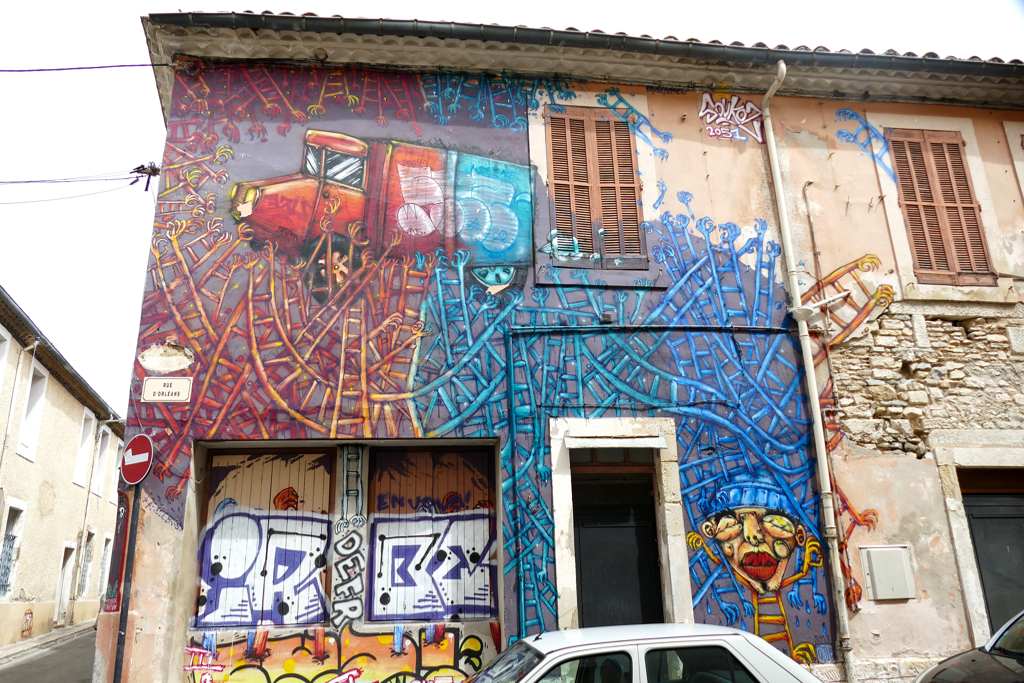
In his work, Soukoz often reflects on cultural, social, and environmental issues, making his art not only visually appealing but also thought-provoking.
GRUMO
Grumo is celebrated for his distinctive and striking murals, which often explore themes such as urban life, nature, and abstract concepts. Rooted in graffiti culture, he paints bold lines in bright colors, typical of street art but with a sophisticated, artistic touch. This makes his art a unique mix of graffiti and art techniques.
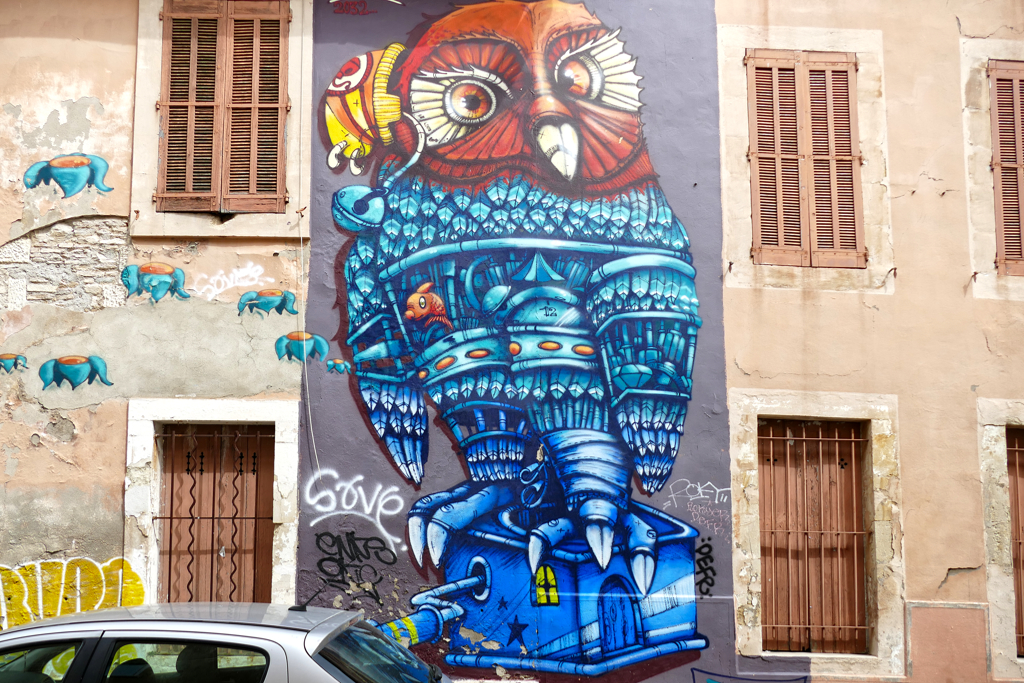
In his murals, Grumo often juxtaposes urban motifs with images of nature, highlighting the coexistence and sometimes conflict between man-made and natural environments.
Grumo’s murals play an important role in revitalizing and beautifying urban spaces, transforming empty walls into engaging works of art that enhance the aesthetics of the community.
All of this makes Grumo a significant and influential figure in the street art community.
Wobe Johnson
Wobe Johnson is an emerging street artist known for his vibrant and dynamic artworks that combine graffiti, abstract forms, and contemporary themes. While detailed biographical information about Wobe Johnson may be limited due to the often anonymous nature of street art, his distinctive style and striking works have gained attention and recognition in the urban art community.

Since Wobe Johnson is rather reserved when using colors and instead uses striking black lines, his motifs appear more drawn than painted. And the fact that they often involve animals, fish, and insects gives his works an almost scientific feel.
While Wobe Johnson is best known for his street art, his work has also been featured in gallery exhibitions, demonstrating his versatility and ability to adapt his style to different contexts.
RNST
You may know RNST by his former moniker, GEST. Well, he dropped that after he was arrested.
Anywho, today he is a well-known street artist known for his mastery of stencil art. He uses multiple layers of stencils to create detailed and vibrant pieces that often feature striking contrasts and bold color palettes. His technique allows him to create complex and extremely detailed images that stand out in the urban landscape.
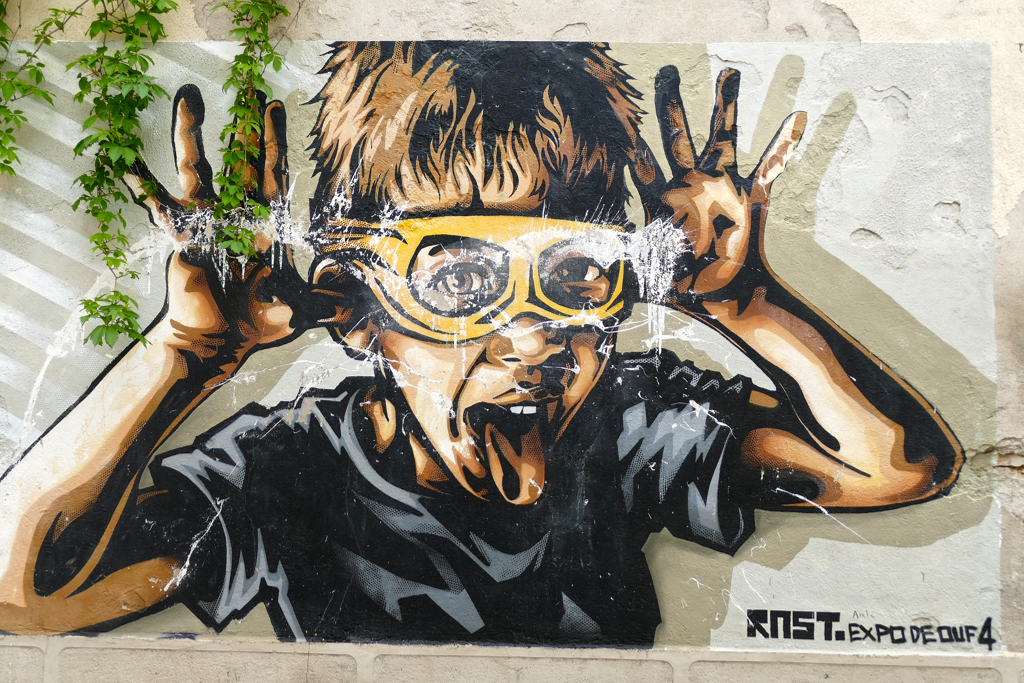
RNST’s motifs often address social and political issues and reflect his views on contemporary societal challenges. Common themes in his work include consumerism, environmental concerns, freedom, and human rights.
These murals can be found in various cities across Europe, but particularly in France.
His work is influenced by both traditional street art and modern graphic design, combining elements from various artistic disciplines. His inspiration often comes from current events, historical figures, and cultural symbols, which he reinterprets through his unique artistic lens.
Apart from creating art, RNST is actively involved in community projects and educational workshops. His goal is to have a positive impact on society through his art by working with local communities to inspire and educate through creativity.
I’m introducing more works by RNST in my post Best Street Art in Marseille.
SWED ONER
Mathieu Taupenas aka Swed Oner lives in the southern French town of Uzès. His career as a muralist began in the late 90s with traditional graffiti. He drew his inspiration from the diversity of cities. Here he first photographs his motifs, which he later transfers into highly detailed and sophisticated hyperrealistic paintings.
These photos are portraits of ordinary people he sees on the street. He creates the portraits expressively in black and white and only adds color accents sparingly and deliberately.
Very often he portrays homeless people near the place where he met them.
The halo that highlights his portraits refers to equality and protection.
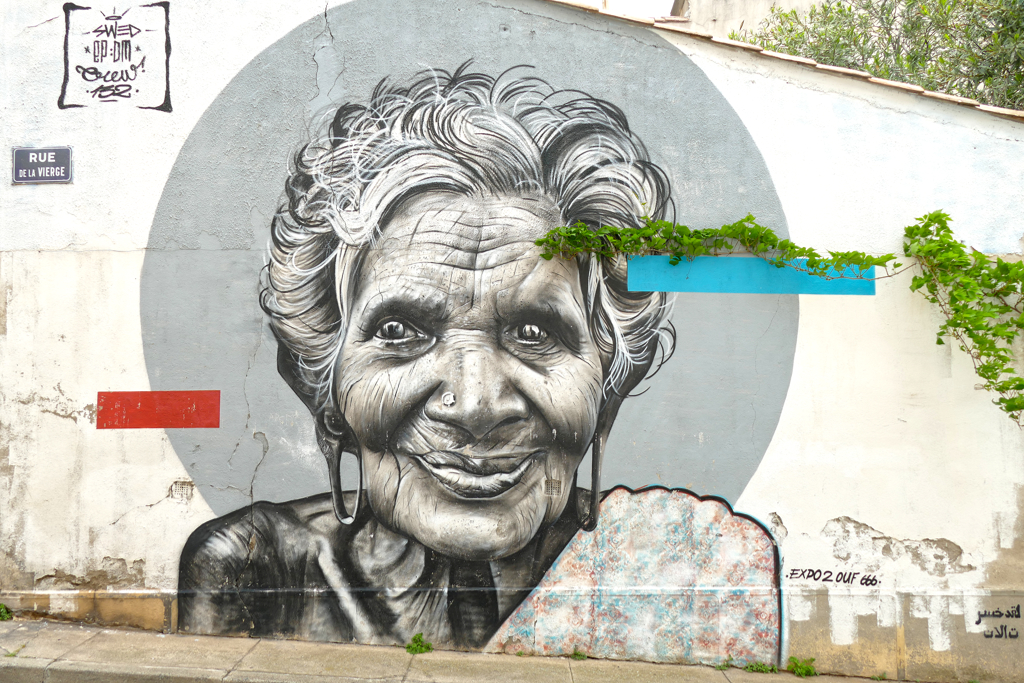
With murals in cities around the world, Swed Oner has gained international recognition by contributing to the global street art movement and influencing other artists. He has participated in numerous community projects and street art festivals.
You can find more of Swed Oner’s works in my post Best Street Art in Marseille.
KogaOne
Matthieu Antignac aka KogaOne is a street artist from Metz in the north of France. His works show dark irony and disturbing compositions in a style between surrealism, realism, and abstract art. KogaOne’s art uniquely combines surrealistic and realistic elements, creating dreamlike scenes that capture both the fantasy and essence of reality. His works often include fantastical creatures, distorted human figures, and otherworldly landscapes.
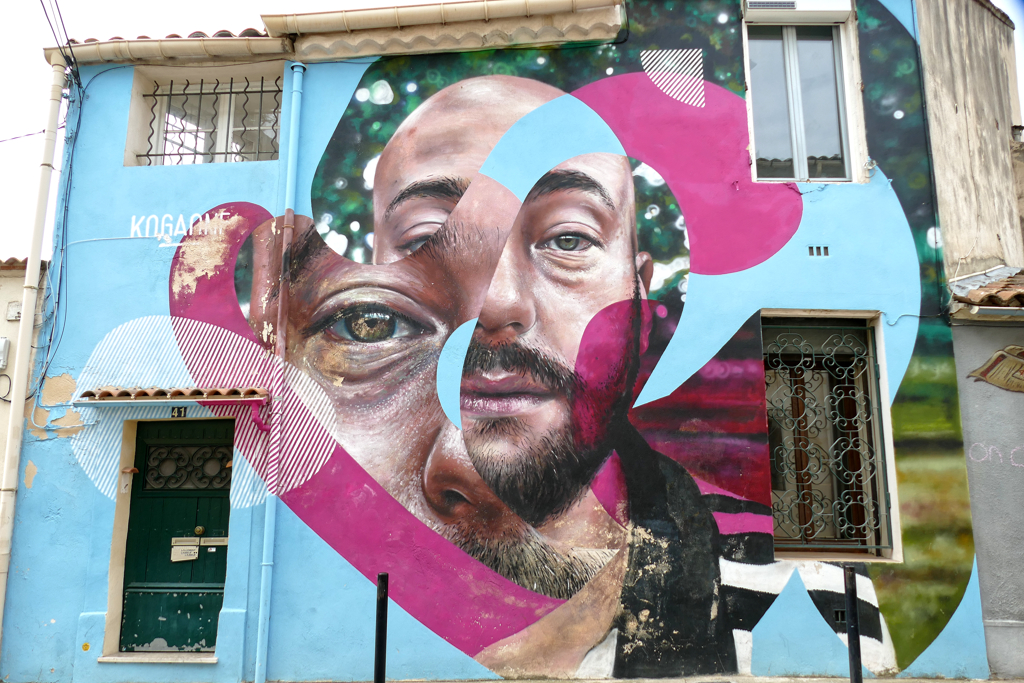
He uses a rich and varied color palette and employs bright and contrasting colors to enhance the visual impact of his murals. This bold use of color brings his intricate designs to life. His murals are admired for their attention to detail and demonstrate his technical skill and attention to minute aspects of his subjects. This level of detail adds depth and realism to his fantastic compositions.
KogaOne is versatile in its use of media and styles, integrating various techniques such as spray paint, brushwork and stenciling. This versatility allows him to create a variety of textures and effects in his works.
Some of KogaOne’s most iconic works include large-scale murals in major urban centers, each characterized by a particular blend of surreal and realistic elements as well as their ability to tell a compelling story.
Definitely one of the most important figures in the French street art scene, KogaOne is known for pushing the boundaries of the genre through his innovative use of style, media and subject matter. His ability to fuse surreal and realistic elements into cohesive and impactful narratives ensures that his work remains relevant and influential.
Aude B.
Mademoiselle Aude Brouiller is one of the many successful French street artists known for her intricate and soulful murals that combine elements of realism and surrealism with a dash of abstraction.
Her work is influenced by various artistic movements, including classical art, surrealism, and contemporary street art. She draws inspiration from nature, mythology, and the human experience, which is reflected in the depth and complexity of her murals.

Brouiller’s art combines realistic depictions of human figures with surreal and fantastical elements and settings. This fusion creates unique and striking contrasts.
Many of her portraits convey deep emotions and often illuminate themes such as strength, vulnerability, and the complexity of human identity.
A recurring theme in her work is the connection between nature and femininity. In her murals, women are often intertwined with flowers, trees, and animals, symbolizing the inherent connection between humans and the natural world.
Brouiller is known for her meticulous attention to detail, particularly in her portraits. The fine lines and subtle shadings in her work demonstrate her technical skill and artistic precision.
Through her depictions of strong, emotional women and nature, Brouiller’s works often carry hidden messages of self-determination and environmental awareness.
Some of Brouiller’s most famous works can be found in cities such as Paris, Lyon, and Marseille. But in addition to her street art, Brouiller has exhibited her work in galleries and led art workshops.
María Corrales Orovio
So here is a completely different kind of street art. The colorful facade was created by María Corrales Orovio. She is an architect from Madrid committed to people-friendly urban transformation.
During her studies, she had the first opportunity to take part in an artistic project in the Atacama Desert. Two years later she implemented the concept in Madrid. This project opened up completely new possibilities for her as an architect.
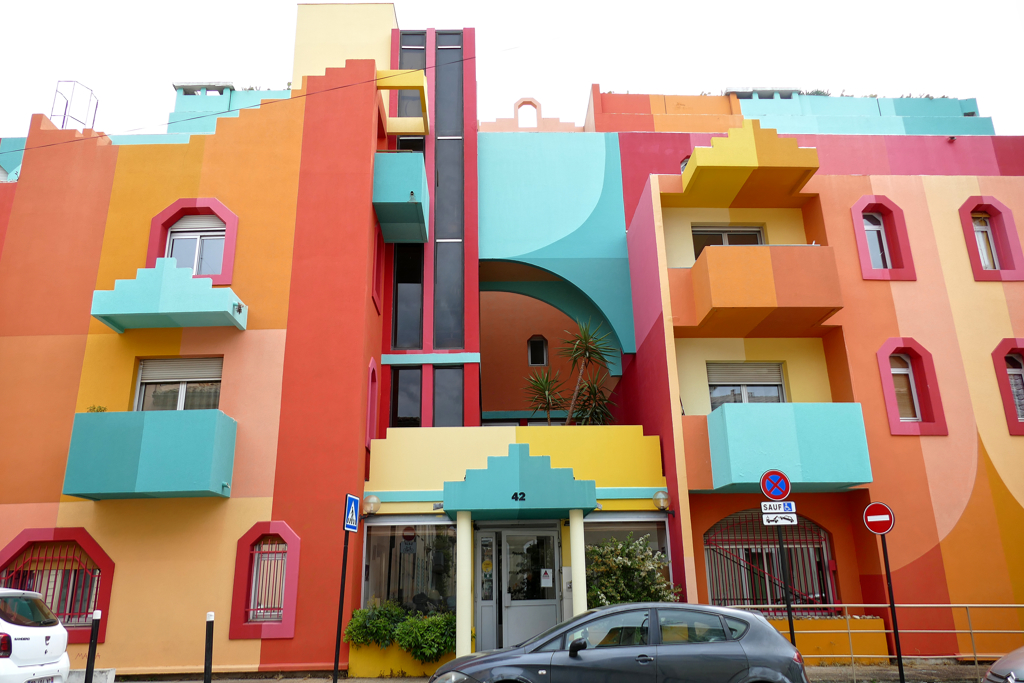
In 2018, María Corrales Orovio was invited to paint the facade of a residential building as part of the Expo de Ouf festival.
Strictly speaking, she created the largest fresco in the history of the festival. The painted area is at least 250 square meters. Local residents, schoolchildren and artists helped the artist for a month.
Le Module De Zeer
As you turn left into Rue de la Poudrière, you are in the middle of a wonderful world of street art. One mural after another is lined up on the right and left, and at your feet, Mehdi Cibille has laid out a black and white carpet in Op Art style.

Mehdi Cibille, better known by his moniker Le Module De Zeer, was born in Paris. However, today he lives and works in Aix-en-Provence. He is known for his geometric creations, which he calls The Module. This module is characterized by its complex, interconnected facets.
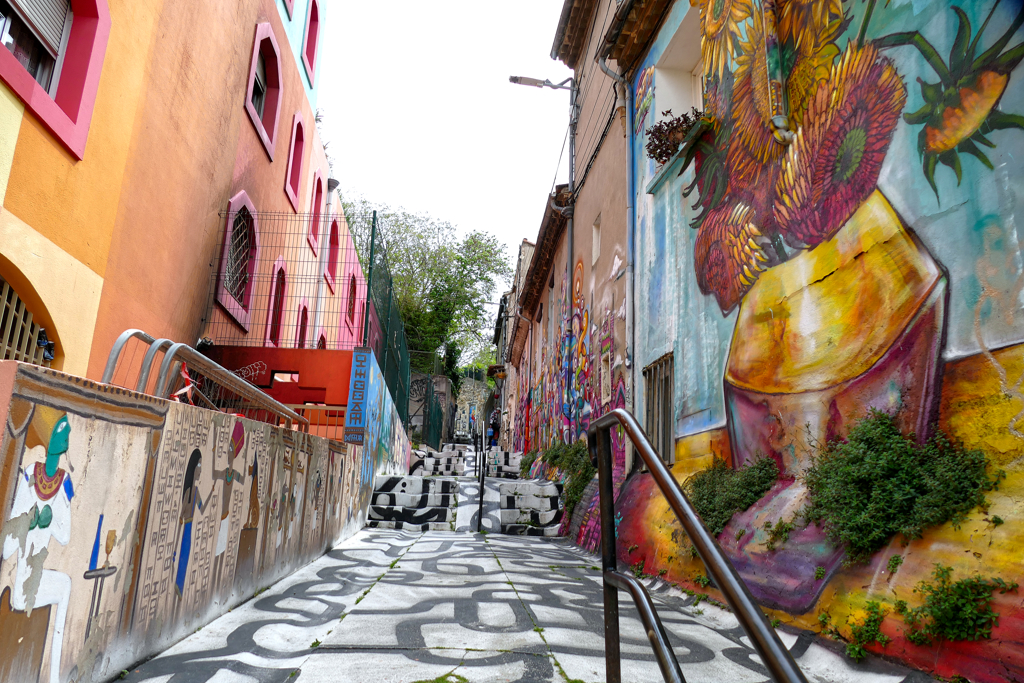
Le Module De Zeer’s artistic career began in the urban environment of Paris, where he initially made a name for himself through graffiti and street art. Over the years his style evolved and today his work is characterized by meticulous precision. Cibille knows how to transform public spaces into visually impressive works of art.
Mehdi Cibille continually tests the boundaries of street art and perfects the spontaneity of graffiti through precise geometric abstraction.
Brokovich
Brokovich is from Hungary and has gained recognition for his vibrant murals in various cities.
His work can be found on walls, buildings, and other urban surfaces, transforming everyday cityscapes into vibrant, engaging works of art. Brokovich’s pieces often reflect his personal experiences and views on society, giving a voice to underrepresented communities and highlighting important social issues.
He is known for his distinctive style that combines elements of graffiti, street culture, and contemporary art. His work is often characterized by bold colors, dynamic compositions, and a unique mix of abstract and figurative elements.
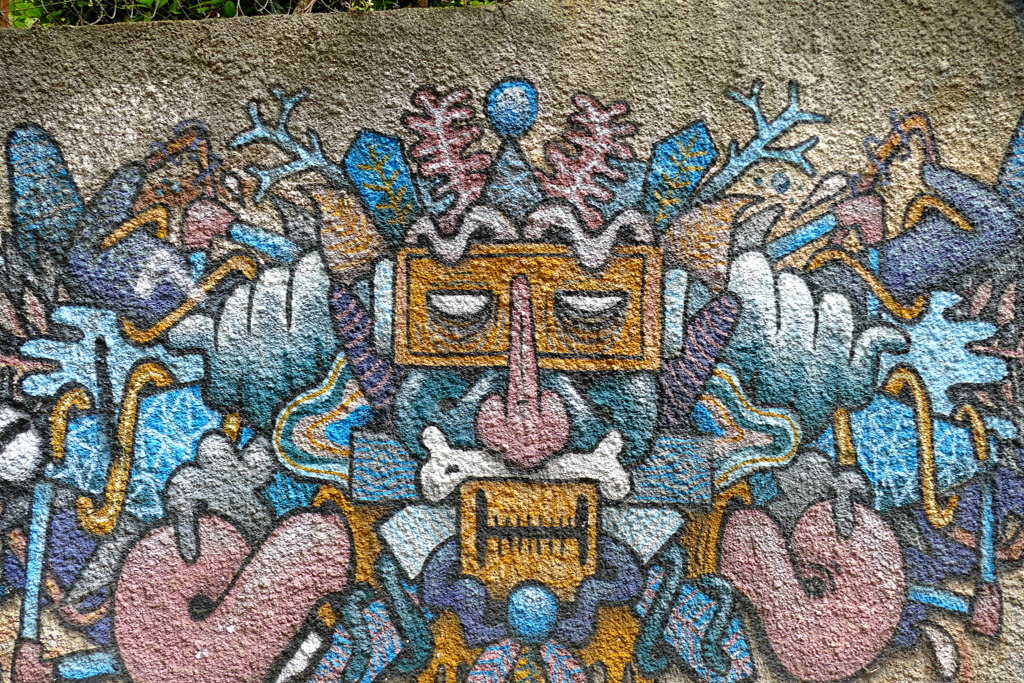
In addition to his outdoor murals, Brokovich’s art has also been featured in galleries and art exhibitions, further solidifying his position in the contemporary art world. His versatility and ability to adapt his style to different media and contexts have earned him recognition and respect from both street art enthusiasts and the broader art scene.
Dire 132
It won’t surprise you that the artist’s real name is not Dire 132, but Bruno Fredal. Although he was born in a Parisian suburb, he was lucky enough to grow up in charming Aix-en-Provence.
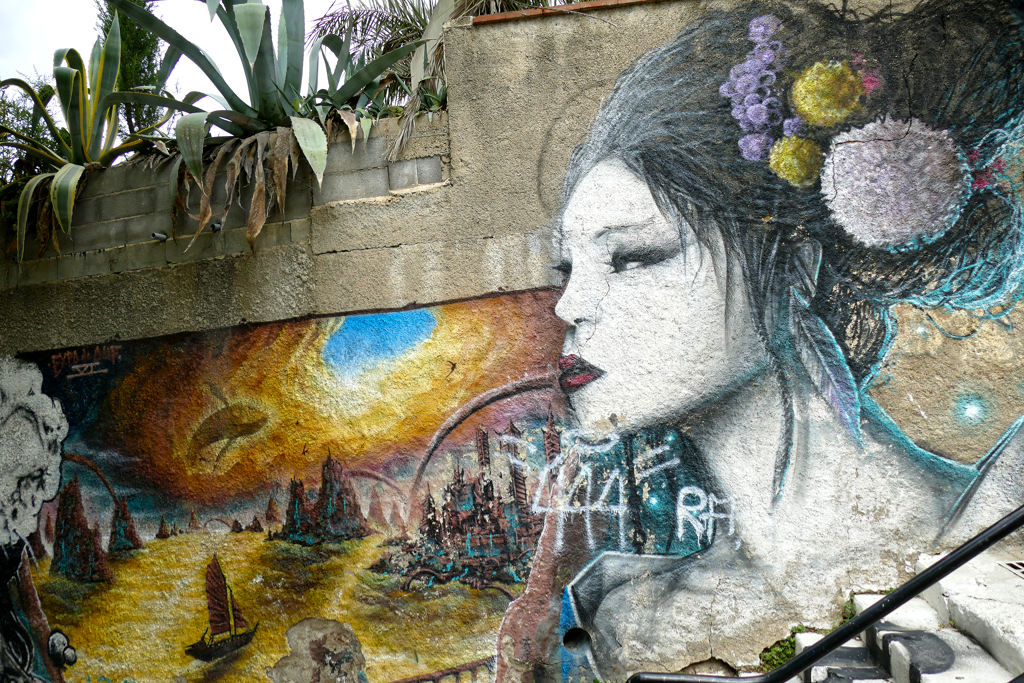
Drawing was his great passion from a young age. In the late 80s, he started with graffiti. Later, he went all in and completed a degree in applied arts which had a strong impact on the his style, obviously.
In terms of motifs, Dire 132 discovered a true fascination with women as he celebrates them in the vast majority of his works. His sensual portraits with a raw style radiate an emotion that is deeply touching.
I’m introducing more works by Dire 132 in my post Best Street Art in Marseille.
SMAK3
Antoine Mak aka SMAK3 has significantly influenced the urban art scene with his unique and recognizable style. Originally from Belgium, SMAK3 has gained international recognition for his thought-provoking murals.
SMAK3’s art features bold, bright colors and dynamic compositions. He often incorporates intricate patterns, surreal images, and abstract shapes, creating visually arresting pieces that capture the viewer’s attention.
Clearly, SMAK3 uses urban art as a medium to comment on contemporary social and political issues, often embedding deeper implications.
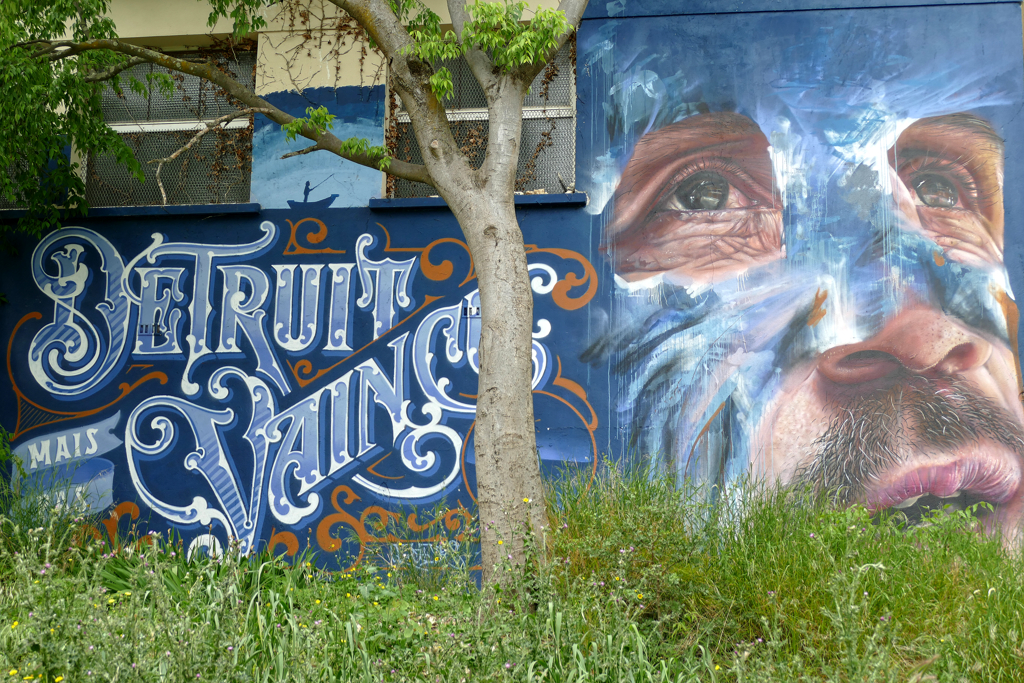
While its roots lie in Belgium, SMAK3’s influence extends throughout the world. He has painted numerous large-scale murals in cities around the world, transforming cityscapes into open-air galleries.
In addition to his street art, SMAK3 also produces works for exhibitions in galleries. This allows him to experiment with different media and techniques, bridging the gap between street art and contemporary fine art.
RODES
Now, the lettering détruit mais pas conquis, alongside the portrait of Smak3, is a vital part of the entire image composition. He comes from Rodes. Rodes is recognized for his distinctive vibrant and stylized lettering.
Since letter combinations, no matter how artistic they are, are often surprisingly meaningless in street art, Rodes often collaborates with figurative artists. Together they then create powerful representations with a clear message. A wonderful example is the mural pictured above, which can be seen in Rue de la Poudrière.
Mahn Kloix
Opposite the mural by SMAK3 and Rodes is another collaborative work by Giuseppe Gütan and Mahn Kloix. Mahn Kloix was born in Paris in 1980, but for the past five years, he has preferred to live in Marseille.
According to his own statement, Mahn Kloix grew up in a family of activists. He himself transferred this family legacy as a driving force in his artistic work.
In 2003 he entered the Gobelins Art School in Paris to train in graphics and applied arts. The young artist also spent part of his studies in Besançon, where he came into contact with the Bauhaus style. That and the aesthetics of the great German and Russian poster artists inevitably led him to the medium of paper.
But over time the freelance artist replaced the academic graphic artist.
Since he came to Marseille in 2010, he has made the old town his creative center.
One of his most personal and impressive projects is a series of portraits of young demonstrators he encountered in Taksim Square in Istanbul. Uprisings in Tunisia and Athens inspired him to undertake further projects.

Mahn Kloix is certainly one of the most complex and profound artists in this lineup. You can find more of his works in my post Best Street Art in Marseille.
Giuseppe Güntan
Giuseppe Gütan was born in 1986 in the Italian city of Salerno. After completing his language studies, he moved to Paris to take art classes. Eventually, he studied applied art at the Atelier des Beaux-Arts in Paris. At the same time, he began his career as a street artist.
Gütan draws inspiration from various artistic movements, including classical art, surrealism, and contemporary street art. He combines these influences in his unique style, which is modern yet at the same time timeless.
A recurring theme in his work is the relationship between humans and nature. His murals often depict this connection and illustrate the symbiosis and tension between the two. Gütan knows how to create dynamic compositions that guide the viewer’s gaze through the mural. He often uses lines, shapes, and color contrasts to create a sense of movement and narrative flow.
Giuseppe Gütan exhibits in various European cities and takes part in several projects and residencies.
In collaboration with other street artists, but most frequently with Mahn Kloix, he has created various large-scale murals.
I introduce more works by Gütan in my post Best Street Art in Marseille.
Cole
Cole is originally from Montpellier where he began as an autodidact by reproducing artists’ works in 2003.
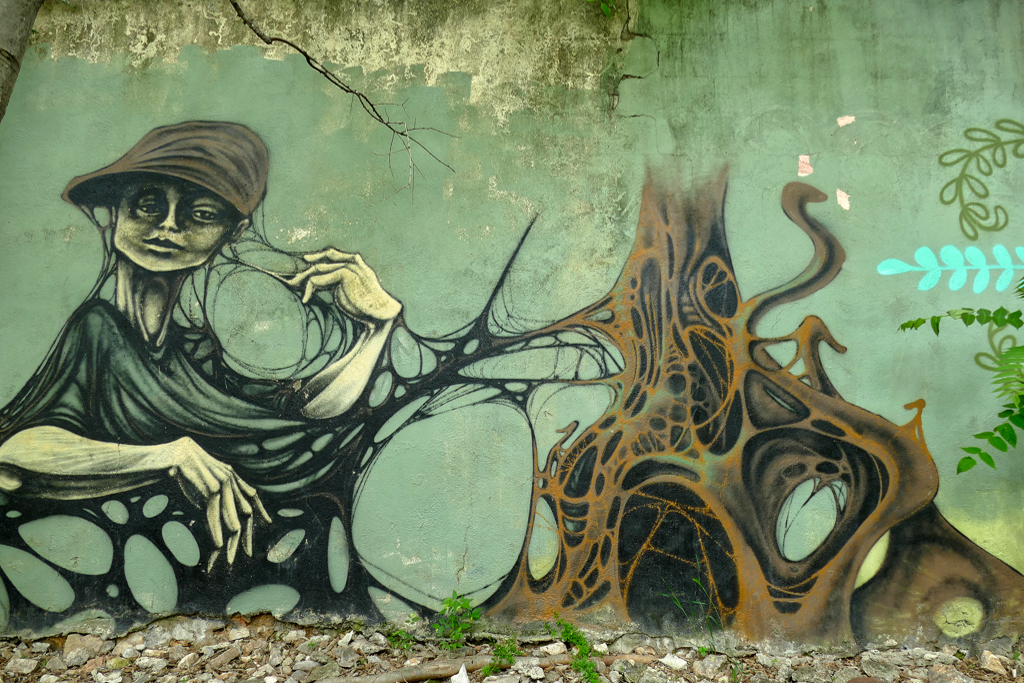
Today, his style is based on abstract forms inspired by cubism.
He uses his art to address social and political issues and offers street art workshops where participants can express their ideas by creating works of art.
FOA
Yann Hostingue from Nîmes is better known by his stage name FOA. He is a street artist appreciated for his vibrant and culturally rich murals. His work is characterized by a deep connection to heritage, storytelling and the use of bold, dynamic imagery. FOA’s art often reflects themes of identity, community and the preservation of cultural history, making him a notable figure in the global street art scene.
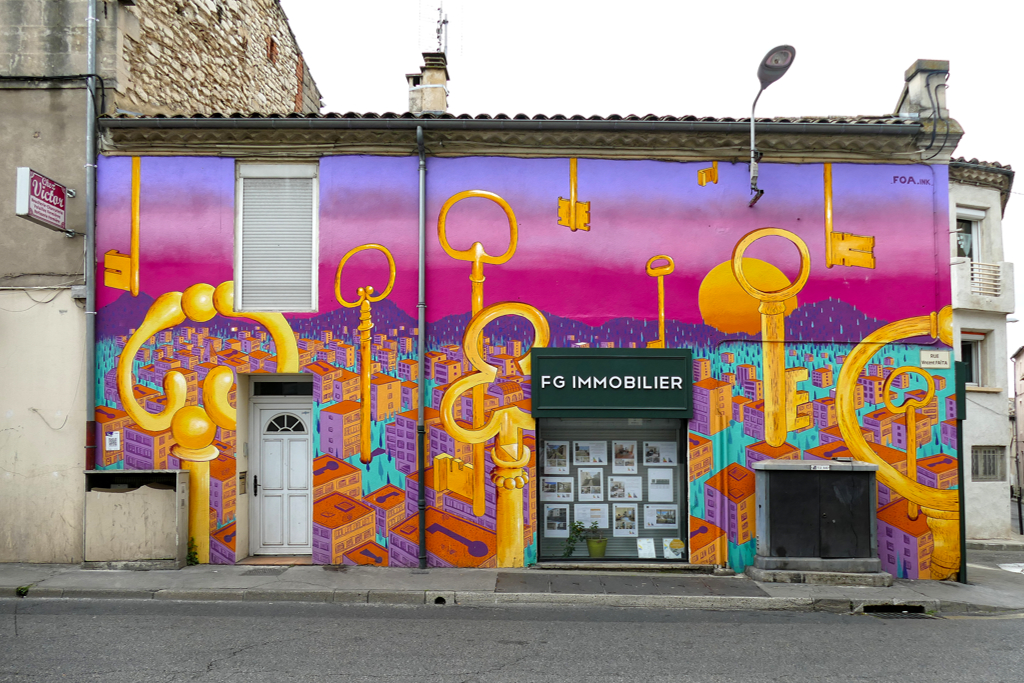
Influences range from traditional art forms and indigenous symbolism to modern street art techniques. This mix of old and new creates a unique style that resonates with a wide audience.
He uses a rich palette of bold and vibrant colors to create his eye-catching pieces. These colors not only enhance the aesthetic appeal of his work, but also convey deep emotional and cultural meaning.
FOA has created numerous iconic murals that can be found in urban centers worldwide. Each piece is unique and features vibrant colors, intricate details, and cultural storytelling.
Elias Taño
Elías Taño was born in 1983. He was working as a graphic designer at various studios and agencies in the Canary Islands, Barcelona, and Valencia.
In 2011 he founded the political theater group Atirohecho together with the artist Carla Chillida, in which he created motifs for his own theater productions as well as for productions by other theaters and music groups.

He also exhibits his graphic works of art solo or in groups in various rooms. He created powerful murals in Spain, Italy, Poland, Chile, Guatemala, and Mexico.
As a teacher, Elio Tano leads courses as part of the master’s degree in illustration at two art academies in Valencia.
I’ve introduced Elias Taño already in my post on Best Street Art in VALENCIA.
Mister Thoms
Diego della Posta aka Mister Thoms was born in Rome in 1979. He started painting graffiti at the age of 17. Nevertheless, he has a background in traditional art and design, which he skillfully incorporates into his street art, combining art techniques with graffiti and mural painting. Today, he is known for his playful and imaginative murals, which often contain a mix of humor, social commentary, and whimsical, surreal elements. His murals often depict fantastical scenes with exaggerated characters and imaginative scenarios, evoking a sense of wonder and curiosity. A characteristic feature of his work is the use of humor and satire. Through clever visual puns and witty commentary, Mister Thoms addresses various social, political, and cultural issues, inviting viewers to reflect on the absurdities of contemporary life.
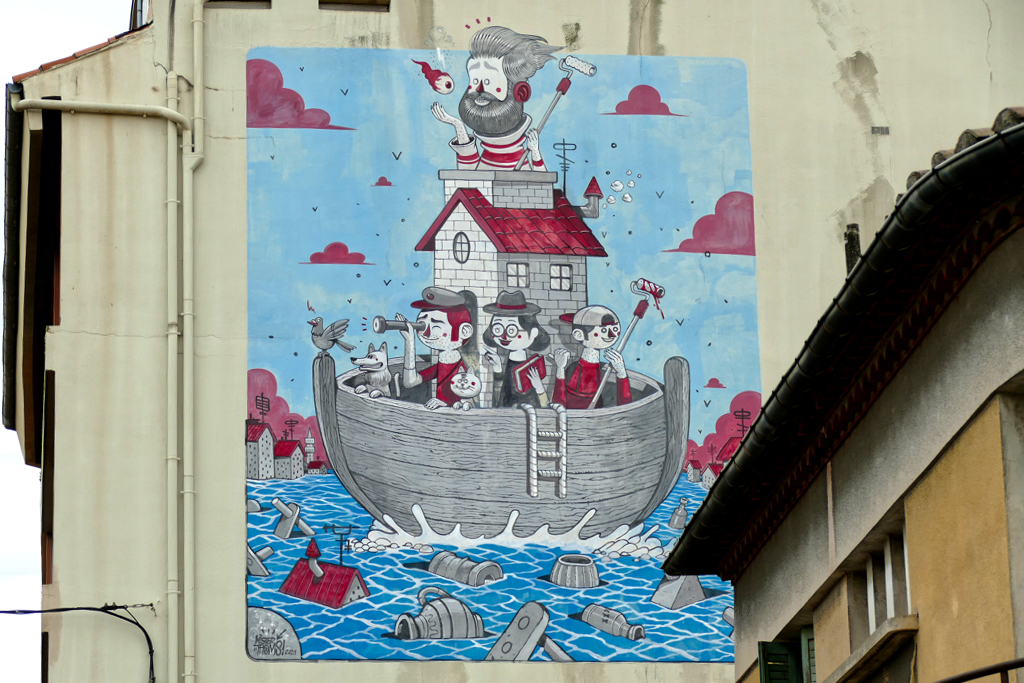
Mr. Thoms’ murals are known for their detailed and intricate compositions. He plans each piece carefully, ensuring that each element contributes to the overall theme and message.
He also sometimes incorporates 3D effects and optical illusions into his murals, adding a dynamic and interactive element to his pieces.
Some of Mr. Thoms’ most famous murals include large-scale pieces in urban centers such as Rome, Berlin, and New York. Each mural is unique and features playful imagery, vibrant colors, and an underlying message.
Beyond street art, Mr. Thoms has exhibited his work in galleries and conducted workshops to bring his techniques and creative process to a wider audience. These activities help expand his reach and influence in the art world.
1sekte
The prize for the cleverest nickname definitely goes to 1sekte. If you pronounce the number at the beginning of the word as un, hence, one in French, with the remaining letters, it sounds like insecte, the French word for insect.
Well, this particular creepy-crawly is a self-taught artist who was informally trained in the graffiti school which are the streets of French cities.
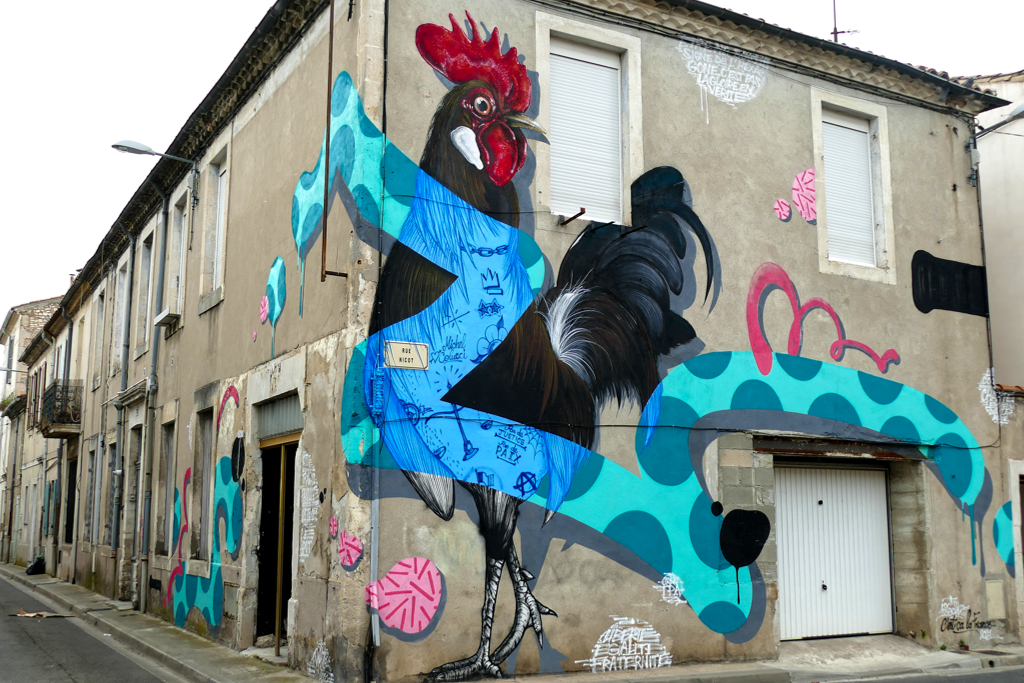
He always had a passion for typography and especially the artistic elements of early old-school graffiti. But after working on typefaces for several years, he turned to mural painting, which took his message to a whole other level.
1sekte mainly paints on streets, undeveloped land, wasteland, and abandoned houses, which he particularly likes. The message of his work then emerges from the specific location.
1sekte is always striving to discover new techniques and does not consider itself to be part of any particular movement. Partly subliminal social commentary makes his work memorable and powerful.
TANK and POPEK
Tank and Popek – somehow that sounds like the title of a Polish television series for children. In reality, these are the monikers of an artist duo from France’s Auvergne region. Growing up in a province full of mystical folklore, they are used to making unreal worlds tangible.
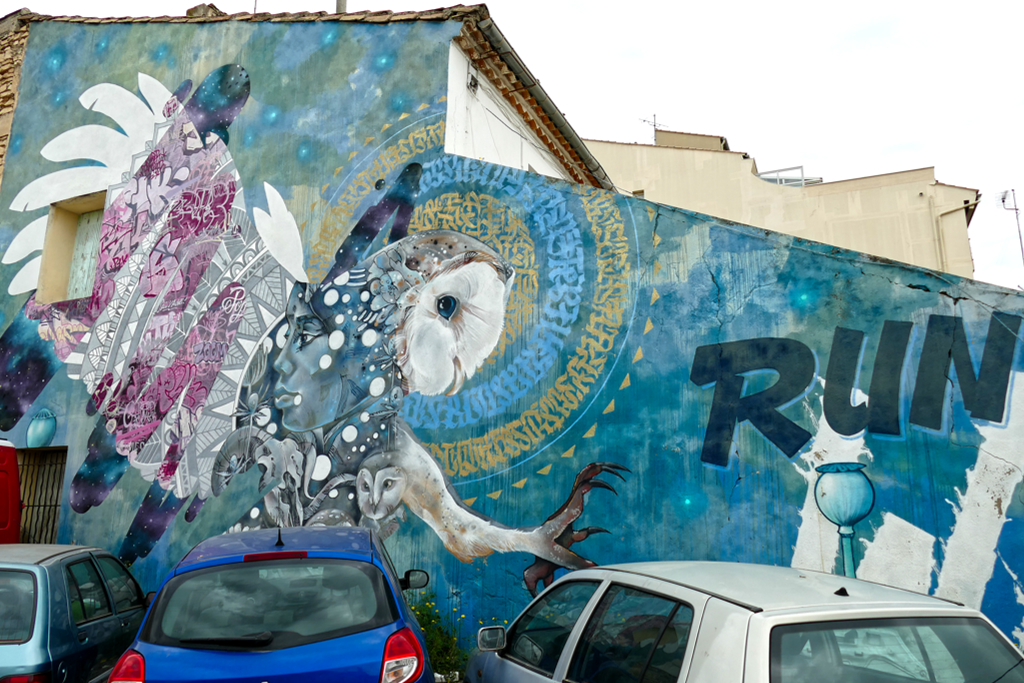
Tank dedicated himself to drawing from an early age. He focuses on depicting fauna and flora as realistically as possible. The illustrator often swaps his pens for sprays and captures his totem animals on the walls.
As a pioneer, Popek travels to cities in search of new painting surfaces. Even after the crew was founded in 2003, he didn’t completely lose sight of his beginnings as vandalism. Today he develops typography and calligraphy with which he complements the joint art projects.
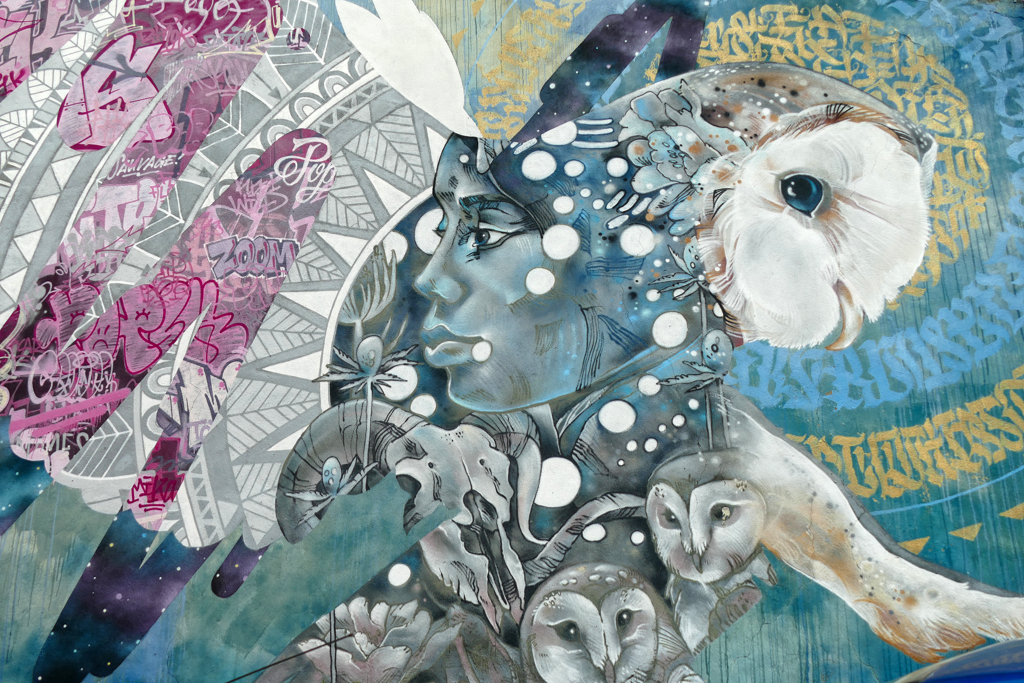
The artists now based in Lyon work in a multidisciplinary manner as painters and sculptors and always also as storytellers. They mix punk’n’poetry as well as graphics’n’graffiti with elegance and freshness.
Arturo Volátil
Arturo Rodriguez Naranjo aka Arturo Volátil comes from the Colombian city of Barranquilla. His works, which he has used to beautify many cities around the world, are full of color and passion.

Volátil strives to implement elements and metaphors of cultural power in his work. In doing so, his work aims to awaken the transformative potential in all of us.
He chose the moniker Volátil, which means fleeting in English, because it fits his mystical motifs. Personally, I think that the name fits perfectly with any type of street art, as it is often subject to change and is rarely permanent.
Arkane
Avignon-based artist Arnaud de Jesus Goncalves aka Arkane develops his style from his passion for painting and photography. These are two very different disciplines which, when combined, enable him to compose motifs and develop his own visual language.
He subtly influences different storylines and uses light and proportions in a targeted manner to ultimately achieve an overall picture full of real emotions. He creates intimate genre scenes in which the viewer becomes an observer.
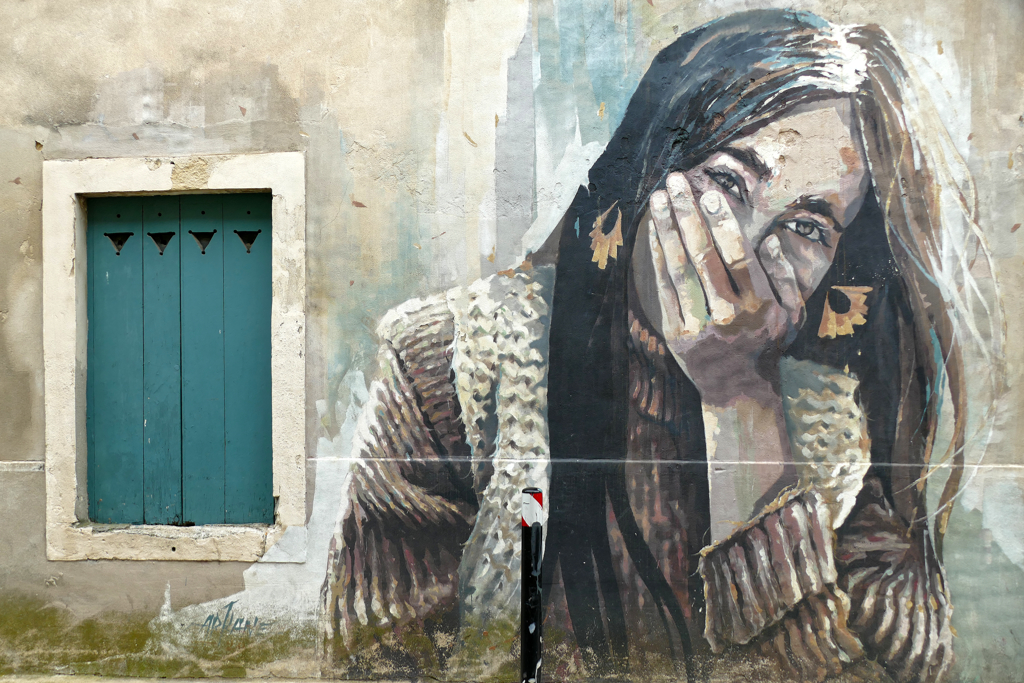
Since he discovered graffiti and murals almost 10 years ago, he has been able to combine his different passions and bring them into a common framework with the help of the urban environment.
The young girl with a mischievous look is the artist’s sister. He portrayed her with a brush based on a photo. The influence of the Impressionist movement of the 19th century can clearly be seen in the style and choice of colors. Arkane freely admits to being influenced by the artist John Singer Sargent.
Primal
Bastien Ghouila aka Primal is also originally from Montpellier, a veritable hotbed of great street artists. He is part of the Atelier Triptyque collective. Primal owes its inspiration to the world of comics. They always surrounded him and encouraged him to tell stories in his own way. So he built up a small artistic universe in which retro-style figures predominate.

The scenes are also complemented by a tangle of geometric and organic elements. In this way, scenarios arise like something out of a bizarre dream.
ARDPG
Arnaud Puig aka ARDPG was born in Périgueux in 1980. However, today he lives and works in Paris.

His mural in Nîmes, consisting of words, seems at first glance like a random list of expressions. Upon closer inspection, you discover that it actually describes the history of ARDPG and of graffiti and street art as a whole.
Of course, it all starts with creation. In that era, graffiti was still defamed as vandalism, which is why the word degradation follows, and immediately after that, repression stands for the suppression of artists in expressing their creativity. But more and more people are becoming interested and enthusiastic about the works on the street, and thanks to outreach activities there is now discussion – the next word on the list. At best, this exchange leads to acceptance. And today it is completely normal for street artists to have exhibitions – whether on the street or in galleries.
Siou
Sylvain Escallon aka Siou was born in Montpellier in 1990. He studied graphics in his hometown, where he still lives and works today.
He was influenced by various comic book authors and was drawn to drawing in all its forms. At the age of 23, he published his first comic book, an adaptation of the novel Lazarus.
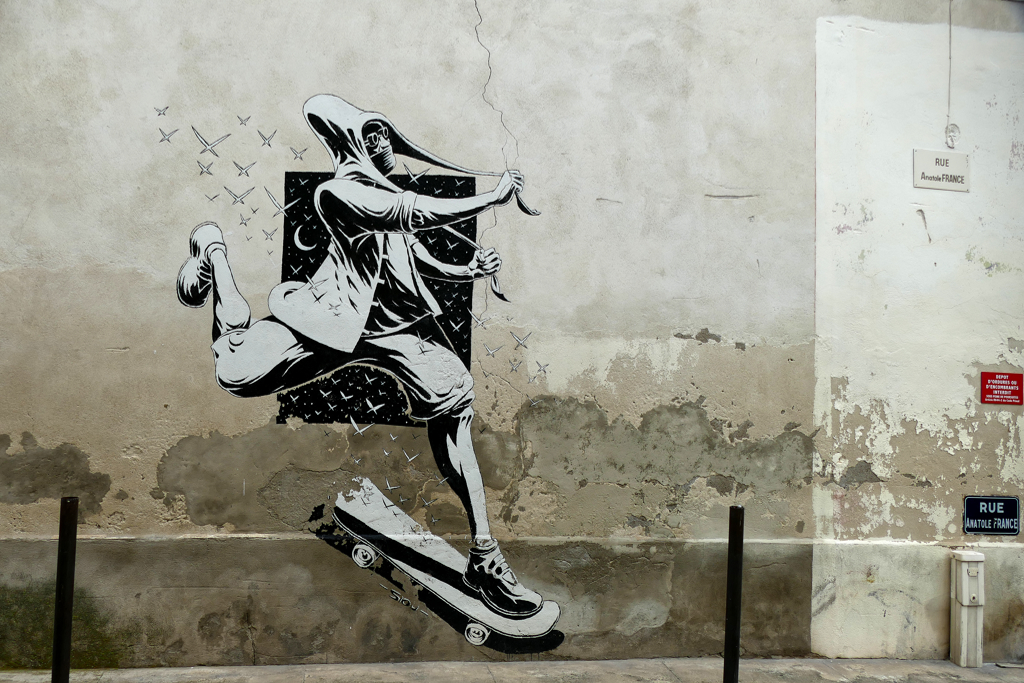
His street art is also influenced by his graphic work: adopting the comic-like appearance, he keeps it in simple black and white. He achieves the clearly defined contours by using stencils.
Sious’s work has a penchant for depicting a poetic world made up of scenes full of details, sometimes with a touch of humor.
Polo 51.67
Another artist who works with stencils is Yohann Lagarde aka Polo 51.67. The advantage of this medium is that it combines speed with precision. It’s not for nothing that Polo 51.67 is also called the template surgeon.

Polo 51.67 is artistically anchored in the graffiti culture of the 90s. After a career as a holiday and leisure center manager and in the animation sector, he opened his own graffiti store in his hometown of Avignon in 2009. Over the years, he specialized in a multi-layer stencil technique. Yet, he never tires of discovering new media and develops artistic techniques that combine fonts, graphics, anamorphosis, and illustrations.
Polo 51.67 is well known in France, his works can be found in various cities. He is also active in the Street Aix Project, a street art walking tour in Aix-en-Provence that includes works by several notable street artists.
On Instagram
That’s a long list of incredible talent – Ouf, indeed! However, if you still can’t get enough and want to see more of the amazing art the above-featured artists have created, you can just check out their Instagram accounts:
1seckte
Adec
ARDPG
Arkane
Aude B.
Isaac Barreda
Brokovich
Cobalt
María Corrales Orovio
Dire 132
Dr Ponce
Nadège Feron
Foa
Charles Foussard
GRUMO
Giuseppe Güntan
jcfort2021
Wobe Johnson
Mahn Kloix
KogaOne
Kopsky
Clara Langelez
Le Module De Zeer
MAYE
Mister Thoms
Loraine Motti
NEAN
Nhobi
Polo 51.67
Primal
Pyrate
RNST
RODES
SEMOR
Siou
Sismikazot
Smak3
Soukoz
SUPO CAOS
SWED ONER
TANK and POPEK
Elias Taño
Tito and Mulk
Arturo Volátil
How to Get Around
The city center of Nîmes is actually not that big. Basically all significant landmarks can be easily reached by walking. And even the Gambetta and Richelieu neighborhoods can be reached and explored on foot.
However, renting a city bike is obviously a valid option. véloTANGO is the city’s official bike rental company and located at the main train station. They charge 3 €uros if you rent a regular bike and 7.50 €uros for E-bikes.
If for whatever reason you need to use public transport, you’re in luck as Nîmes has a great net of regular buses as well as so-called tram-buses. Also, tickets are pretty cheap: For 1.60 €uros, you can travel for one hour as much as you please! There are also passes for two to ten rides which makes every trip a little cheaper. For instance, the ten-trip pass costs 12.30 €uros. Finally, there is a day pass for 4 €uros.
To check your route and connections, just use Google Maps. The App even informs you when the bus is late. While on weekdays, buses are going every ten to twenty minutes, there are fewer connections on weekends, obviously.
Map
This map should help you to find the murals I’m introducing in this post. Clicking on the slider symbol at the top left or the full-screen icon at the top right will display the whole map including the legend.
Looking for the Best Street Art in Nîmes was only one of the awesome things I got to do during my visit. In my post One Day in NÎMES – What Not to Miss in the Most Roman City of France, I take you on a comprehensive city tour.
Pinnable Pictures
If you choose to pin this post for later, please use one of these pictures:
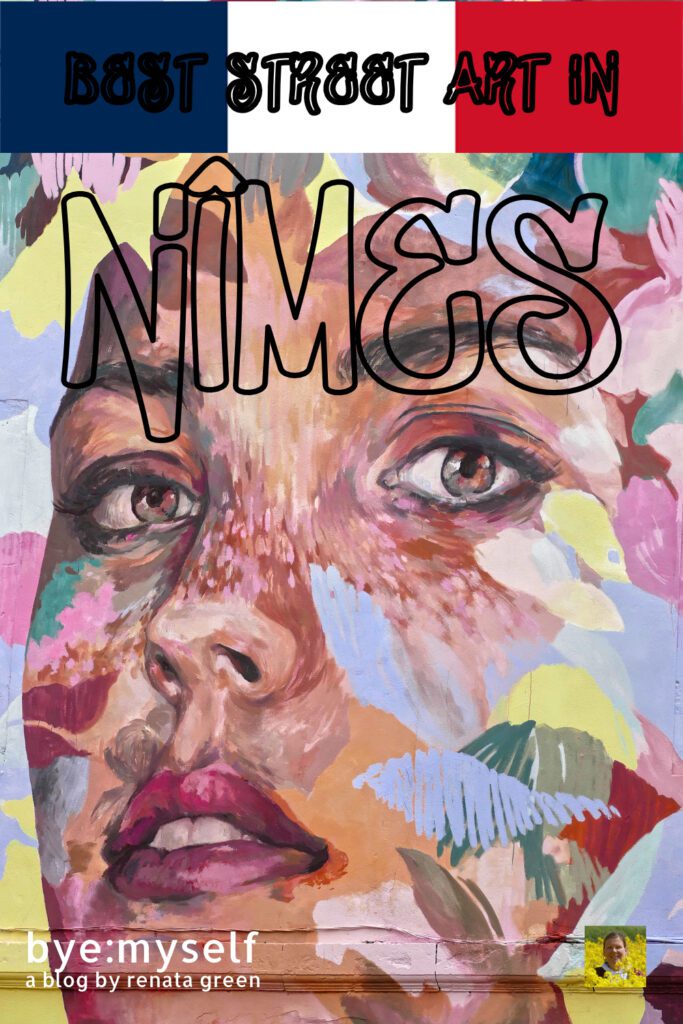

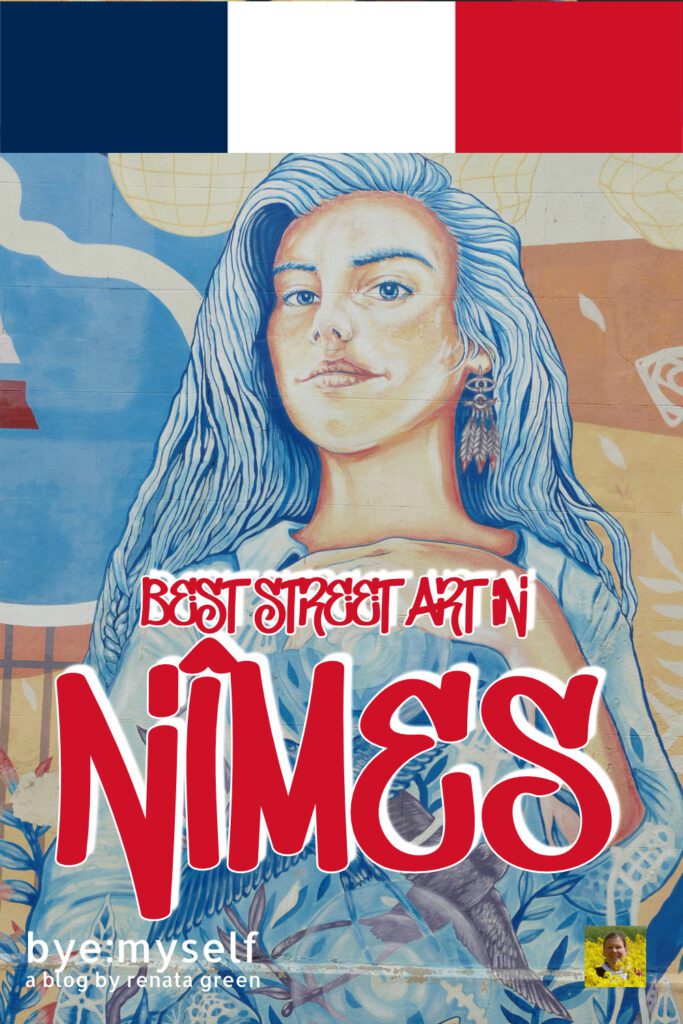
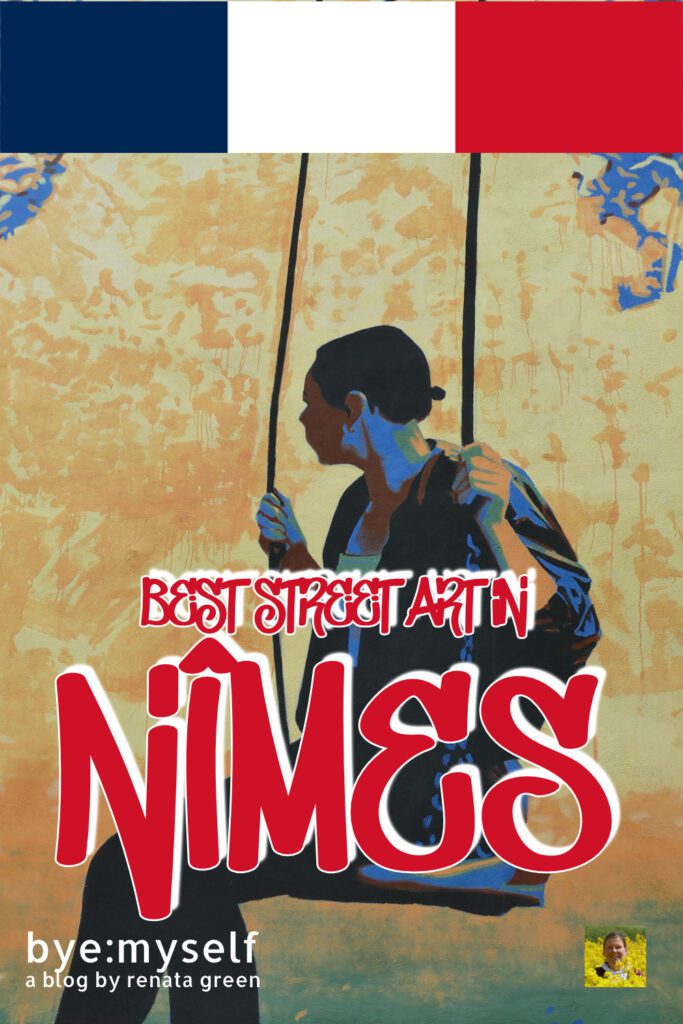


Did You Enjoy This Post? Then You Might Like Also These:
The Best and Most Beautiful Beaches of Naxos
Best Street Art in LISBON – Part III: Moscavide
What Not to Miss in ARUBA, the Caribbean A-Lister
Guide to PUERTO DE LA CRUZ – a Town Full of Contrasts
MAGNIFICENT MARTINIQUE: Ten Places Not to Miss on Your Visit (even when exploring by public bus)
Murals in CURACAO: The Best Street Art Projects in Willemstad
The Amazing Murals of the Hotel Ruins of Alyko
BRISTOL – What to Do on the Best Weekend Break You’ll Have in a Long Time
* I am very appreciative that Office du Tourisme de Nîmes supplied me with a complimentary Nîmes City Pass. Nevertheless, the description of all activities and opinions on their services are mine and were in no way influenced by my cooperation partner.

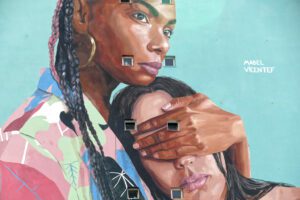


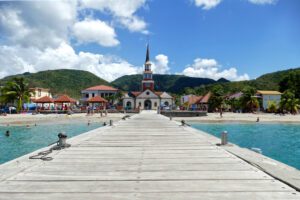

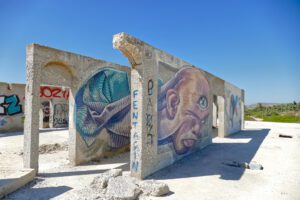
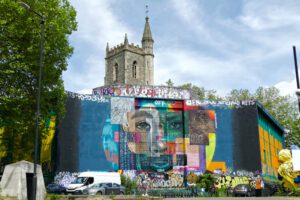
Please do not confuse “tagging” with any kind of art. Those are just bored kids with spray paint who want to see their names up on walls. Give them a blank canvas and they wouldn’t know what to do with it. Their originality or talent is on the level of a school kid. Sadly, more and more European cities are embracing tagging as “street art”, even when it defaces historical monuments. Murals are a different story (usually) and I like much of what you have photographed and am glad you told me about them. Too bad taggers seem to think it’s OK to add their names to them.
I totally agree – but none of the artists I’m introducing in my post are vandals or taggers!
I am truly thankful for sharing this fantastic piece of writing about this place.
Thank you for your kind words – I’m always here to help 🙂 Happy travels!